For pet owners who are conscientious about the environment, the garbage pail may contain mostly…
The post The Poo Problem: Pet Waste appeared first on Earth911.
For pet owners who are conscientious about the environment, the garbage pail may contain mostly…
The post The Poo Problem: Pet Waste appeared first on Earth911.
It was in the early morning when we first spotted Aracy, positioned near a small waterhole in Brazil’s southern Pantanal region. We followed her through the grasslands, watching the jaguar meander among trees and along the occasional dirt pathway—at one point, even walking within several feet of our open-sided 4×4 vehicle—until she spotted a herd of capybaras grazing beside a lake. “Keep quiet,” our guide Lucas whispered. “She’s about to make her move.”
In an instant, the capybaras were running into the water with Aracy sprinting behind them, hoping for an early day feast. Although luck wasn’t on her side this round, the enormous feline put on a show for the ages.
Wildlife is a given in Brazil’s massive Pantanal, a more than 75,000 square-mile UNESCO Biosphere Reserve that’s home to the largest tropical wetlands and flooded grasslands on the planet. Everything from squadrons of peccaries (hoofed mammals that resemble pigs) to alligator-like caiman call this incredible natural region—one that stretches across portions of Brazil, Bolivia and Paraguay, covering an area that’s equivalent to the size of Belgium, Holland, Portugal and Switzerland combined—home. In fact, the Pantanal hosts South America’s densest concentration of wildlife: we’re talking animals as varied as giant anteaters, musk deer, tapir and blue-and-yellow colored hyacinth macaws. Impressive, since many visitors flock to the continent’s other fauna-filled destinations, like the Amazon rainforest, without knowing that these wetlands exist.
These days, however, the Pantanal is gaining traction among wildlife lovers, thanks in large part to the efforts of Onçafari, a project established to promote conservation through ecotourism, mainly habituating jaguars to safari vehicles with the notion that the more people see these stealth cats in the wild, the more they’ll likely do something to save them.
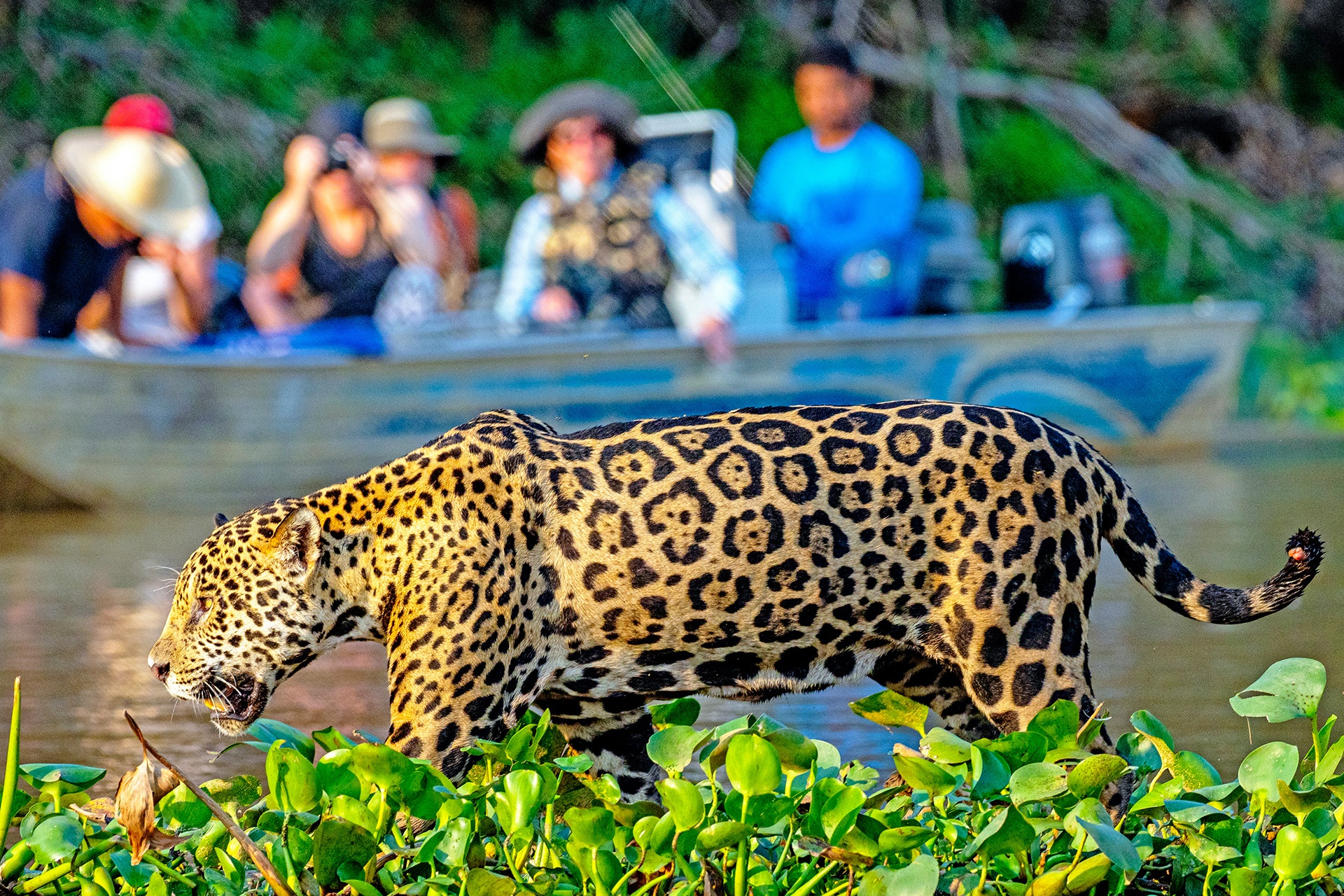
© Cassiano “Zapa” Zaniboni
Former Formula 1 racing driver Mario Haberfeld established Onçafari in August 2011. Its name is a combination of “onça,” the Portuguese word for jaguar, and “safari,” which means journey in Swahili. Haberfeld was inspired to start the project after visiting the African continent, where wildlife such as lions, elephants, and hyenas have grown up around safari vehicles. The Brazil native wanted to bring the same type of ecotourism to the Pantanal, helping to preserve its biodiversity in the process. Although the organization also works with other species ranging from giant otters to crab-eating foxes, in the Pantanal, it’s the jaguars that draw the most attention.
Jaguars are similar to leopards, their African counterparts, though they’re stockier than leopards and more muscular. Each one is also highly unique. Some are more golden in color than others, their whiskers longer or shorter, and their faces narrower or fuller. Historically, their range stretches from Argentina north up to Arizona’s Grand Canyon, though their population has decreased by 25% in just over two decades, spurred in large part by deforestation and illegal logging. Today, jaguars occupy less than half of where they once roamed, with sightings only as far north as Mexico’s Sonora state and occasionally crossing the border into Arizona. Seeing one in the wild has long been a remarkably rare experience.
Lucas Morgado is an Onçafari biologist who is well-versed in tracking wildlife. He’s also our safari guide in Brazil’s southern Pantanal. He tells us the story behind Aracy. How she was born back in 2020 and has been in the proximity of vehicles all of her life. She’s the daughter of Isa, one of the first two jaguars to be reintroduced by Onçafari to the Pantanal after losing her mother at a young age. And that she’s missing the tip of her left ear. We also learn about jaguars in general: things like their having the strongest bite of all cats—even lions and tigers—how the rosette patterns on their fur are as unique as human fingerprints, and while they’re typically solitary creatures, these elusive cats sometimes form coalitions to survive.
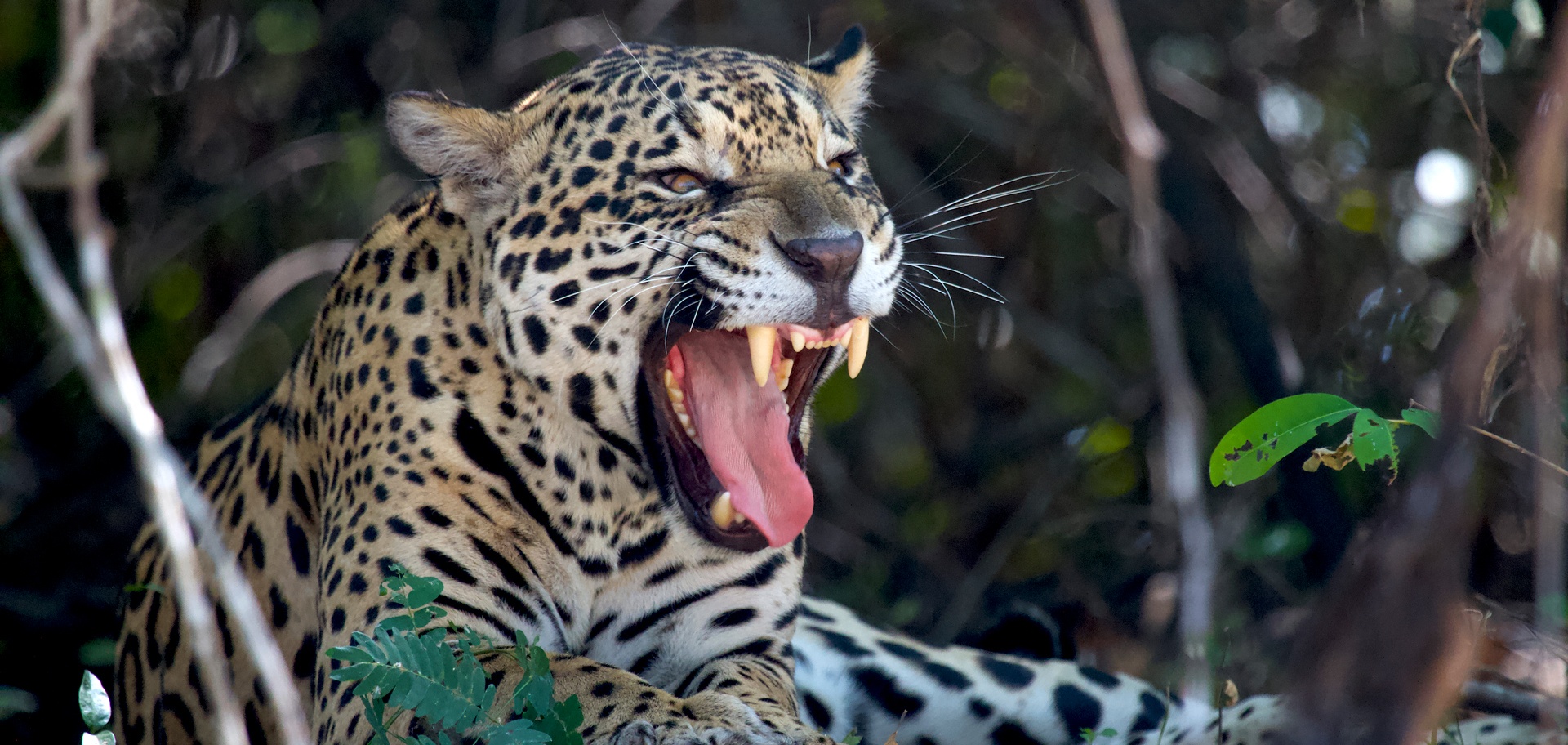
©Helder Brandao de Oliveira
Of the estimated 15,000 to 64,000 jaguars remaining in the wild, more than half of them live within the Amazon Rainforest and the Pantanal. About 60 to 80 jaguars of these reside inside the 204-square-mile Caiman Ecological Refuge, a renowned private reserve that happens to be the site of our spacious lodge, as well as Pantanal’s Onçafari jaguar team and scientific research center. Here, the project’s team members are constantly evaluating the health of the felines and monitoring their behavior through motion sensor cameras, direct observation, and a handful of GPS-equipped radio collars that can map their locations through different frequencies. But of the five jaguars that we end up spotting over the course of two days (with names like Timbo, Aroeira, Hades and Flor), only one of them has been collared to provide Onçafari with its coordinates. The other sightings are merely a testament to how well the jaguar habituation program is working.
According to Onçafari, only 16% of guests at the Caiman Ecological Refuge reported seeing jaguars in 2013. Ten years later, the percentage was 100. Although Onçafari never guarantees a sighting, the likelihood of spotting a jaguar (or jaguars) here really is possibly the best on the planet.
After about 40 minutes in Aracy’s presence, it’s time to move on. But before starting up our 4×4 vehicle’s engine, Morgado clears his throat. It’s a way to indicate to the felines that there’s a louder sound coming and remind these big cats that they can keep on keeping on without ever feeling threatened.
Natural Habitat Adventures’ Jaguars & Wildlife of Brazil’s Pantanal includes a few nights lodging at the Caiman Ecological Refuge and time spent with the Onçafari Jaguar Project, as well as one of the reserve’s spectacular Pantaneiro cowboy dinners—complete with an array of spit-roasted meat. Participants also have an opportunity to spot jaguars in the northern Pantanal and see other species like toucans, howler monkeys, giant armadillos and big-headed swamp turtles. Want to make your experience even more amazing? Tack on a trip extension to see one of the world’s mightiest waterfalls, the more-than-mile-long Iguazu Falls, straddling the border between Brazil and Argentina.
The post Tracking Jaguars with the Onçafari Project: Conservation Travel in Brazil’s Pantanal first appeared on Good Nature Travel Blog.
Recycling frozen food boxes – also known as wet-strength paperboard – may not be quite as straightforward as it seems. Read on for the cold, hard truth.
The post Recycling Mystery: Frozen Food Boxes appeared first on Earth911.
The island Borneo offers an unparalleled opportunity for wildlife photographers to capture the unique biodiversity of one of the world’s most iconic rainforests.
Borneo holds approximately 6% of the world’s biodiversity on only about 1% of the planet’s land, with over 15,000 plant species, 220 mammal species (including 44 that are endemic), and more than 420 bird species.
However, much of Brneo’s biodiversity is under threat from deforestation and other human activities, making conservation efforts critical.
By planning a shot list around the critical role of Borneo’s wildlife—particularly its orangutans—you can tell a compelling visual conservation story about the importance of its animal species to the ecosystem and local communities.
Orangutans are the stars of the Borneo rainforest, and capturing them in their natural habitat is crucial.

These wide shots can emphasize the vast, towering trees of the lowland rainforests, particularly in Sepilok Orangutan Rehabilitation Centre, where young orangutans learn survival skills before returning to the wild. In the wide shots, aim to make the orangutans small in comparison to the trees to highlight the grandeur of their habitat and the scale of the ecosystem they inhabit.
These images should give viewers a sense of the orangutan’s environment and their dependence on the canopy. Orangutans rarely descend from the trees, so wide shots showcasing the dense, towering forest canopy with an orangutan nestled among the branches provide critical context for their arboreal lifestyle.


Nat Hab Expedition Leader © Court Whelan
Orangutans are essential seed dispersers in the forest, and capturing this behavior is important for illustrating their ecological role. Zoom in to catch the detailed action of an orangutan eating, especially if it’s discarding seeds—a behavior that helps regenerate the rainforest.

Tight shots should show the texture of their fur, their dexterous hands, and the fruits they are consuming. These images will emphasize their key role in the ecosystem, as orangutans help to spread seeds throughout the forest floor, ensuring plant biodiversity.

Nat Hab Expedition Leader © Court Whelan
The Kinabatangan River is home to a wide array of wildlife, including the distinctive proboscis monkeys, which are endemic to Borneo. As you cruise along the river, look for opportunities to capture these monkeys high in the trees, their exaggerated noses adding character to the frame.

Nat Hab Expedition Leader © Court Whelan
Consider shooting at sunrise or sunset to bathe the scene in golden light, offering a warm contrast to the greenery of the rainforest.
Proboscis monkeys are often seen in large social groups, making for dynamic shots that show both the individual characteristics of the monkeys and their interactions within their troop. These shots can serve as an additional story element to complement your orangutan focus, showcasing Borneo’s overall biodiversity.

Nat Hab Expedition Leader © Court Whelan

Nat Hab Expedition Leader © Court Whelan
Borneo is home to the endangered pygmy elephant, and getting a close-up portrait of this rare species can be a highlight of your trip. While cruising the Kinabatangan River or exploring the Danum Valley, keep your camera ready for encounters with these gentle giants. Portraits should focus on the elephant’s eyes, tusks, and skin texture, creating an intimate connection between the viewer and this endangered species.

Capturing an image of a mother elephant with her calf can add another layer of emotional impact, showcasing the familial bonds within elephant groups. This also reinforces the conservation message, as pygmy elephants face significant threats from habitat loss and human-wildlife conflict.
The tropical plants and flowers of Borneo’s rainforests are vibrant and diverse, making them ideal subjects for wide shots of the forest floor or close-ups of individual plants. Focus on capturing the colorful and intricate details of rainforest flowers, such as orchids, which are plentiful in Danum Valley. These flowers play a crucial role in the ecosystem and are often overlooked in wildlife photography.

Nat Hab Expedition Leader demonstrates sustainable agriculture. Photographed by © Court Whelan
In addition to wild plants, local fruits found in Borneo’s markets offer a human connection to the rainforest. Capturing the fruits—such as durian, mangosteen, or rambutan—can illustrate the connection between the forest and the livelihoods of local communities. Adding a human element, such as a market vendor or a person eating fruit, will broaden the narrative and tie human life to the rainforest.

Nat Hab Expedition Leader © Court Whelan

Nat Hab guest looks up to the canopy. Photographed by Expedition Leader © Court Whelan
Photographing orangutans with their offspring provides not only a heartwarming image but also a powerful message about the importance of protecting these vulnerable animals. In the wild, mother orangutans stay with their young for up to eight years, teaching them essential survival skills.

Capturing this bond with close-up shots of mother and child will resonate with viewers, fostering a connection that can motivate action toward conservation efforts.

© Brad Josephs
Creating a shot list that encompasses a wide range of wildlife, flora, and human elements allows you to capture and share a compelling conservation story during a Borneo Wildlife Photo Expedition. Whether you focus on orangutans as keystone species or explore the interconnection between wildlife and local communities, each shot can play a role in educating and inspiring conservation action.

Nat Hab guests. Photographed by Expedition Leader © Court Whelan
Want to get started in conservation photography? Nat Hab Expedition Leader and Chief Sustainability Officer Court Whelan emphasizes,
“To me, the key to success is aiming for simple stories that you connect with. Could you create a photo essay on the importance of orangutans to the ecosystem? This is absolutely conservation-focused and accomplishes the goal of educating and motivating action on a species you’re likely to see.”
With this shot list and a deeper understanding of Borneo’s wildlife, landscapes, and conservation challenges, you’ll be ready to capture iconic photos that showcase Borneo’s beauty and help protect it,and inspire others to protect it too.
Whether you’re preparing for your upcoming Borneo Adventure or just want to learn more about this lush island, Nat Hab has got you covered. Check out this Know Before You Go Resource page for an array of helpful resources, from wildlife and weather guides to compelling first-hand accounts written by Nat Hab travelers and staff. You’ll especially want to check out the orangutan photo tips!

Nat Hab Expedition Leader beside proboscis monkey. Photographed by guide © Bedley Asun
The post 6 Iconic Shots to Capture on a Borneo Wildlife Photo Expedition first appeared on Good Nature Travel Blog.
Humans create a lot of waste, but when you throw something away, how much do…
The post How Curbside Recycling Works appeared first on Earth911.
In 1994, a lone wolf crossed the border from Italy into Switzerland. Within a year, there were two, then pups and sporadic sightings.
By 2012, Switzerland had its first stable wolf pack in well over 100 years.
The pack’s dominant female, known as F07, was first spotted by a camera trap in the canton of Grisons in southeaster Switzerland (where Davos, Klosters, and St. Moritz are) in 2011, when she was a year or two old.
For nine years F07 lived with the same mate, M30, on the Calanda Massif above the city of Chur—one of the longest continuously inhabited (by humans) places in Europe. They had 46 pups together in 8 litters.
Their pack was called Calanda, and their offspring have spread throughout the Alps and paired with wolves from Italy and France.
The Calanda pack has disbanded, but led to many more. By mid- 2023, Switzerland was home to at least 200 wolves in about 25 packs roaming primarily in Alpine environments.
By 2025, Switzerland is projected to have approximately 300 wolves in 40 packs.

Wolves returned to Yellowstone around the same time as Switzerland, but quite differently. On January 12, 1995 a horse trailer carrying Canadian wolves passed through the gate into Yellowstone National Park’s northwest entrance. Wolves had been absent from the park for nearly 70 years.
From 1995 to 1997, 41 wolves from Canada and northwest Montana were released in Yellowstone and dispersed to establish territories outside the park.
As of January 2024, at least 124 wolves roamed Yellowstone National Park in ten packs. Wolves in Yellowstone sit at the core of a larger population—approximately 500 wolves—throughout the much larger 34,375 square mile Greater Yellowstone Ecosystem.

Gray wolf pack, Yellowstone National Park
There are similarities and differences as wolves return to Switzerland and Yellowstone. One thing is nearly identical: it’s controversial.
Set in Gardiner, Montana just outside Yellowstone National Park, Nat Hab Film’s Big Bad Wolf shares conservation challenges and local perspective on the reintroduction of wolves. One resident said, “I’ve yet to find anyone who’s totally neutral about wolves; I think everyone has a strong opinion.”
The debate sounds different because it’s shaped by local culture, but almost everywhere people are taking sides on how wolves should be managed.
Around Gardiner, Montana the economic value of wolf conservation travel is massive. One local study found that in 2022 wolf-viewing brought at least $82 million into the Greater Yellowstone Ecosystem. In the same year and county, the state paid out only $3,243 to ranchers for two wolf-related livestock deaths.
In Switzerland tourism of a different kind shapes thee debate. The pastoral culture that has developed in Switzerland over the last 150 years values freedom, peace and tranquility (read: quiet). The mountains have become hikers’ paradise, where herds of sheep, cattle and goats graze Alpine meadows unfenced and almost always unattended.

Letting sheep roam the Alps unattended during summer is a cherished Swiss tradition. Neither shepherds nor livestock guardian dogs have been widely used here in generations.
The Swiss debate on wolves is marked by a surprising, vocal resistance to livestock guardian dogs and fences. In some locales voters have even called for a complete ban of livestock guardian dogs, arguing that they scare off alpine tourists. Most news coverage of livestock guardian dogs frames them as costs to taxpayers.
When it comes to livestock guardian dogs, I am biased. I arrived alone in Switzerland from the USA with a Great Pyrenees-German Shepherd mix I met at the Boulder Valley Humane Society when he was only 8 weeks old. I always say I’m never sure who rescued whom.
Now, years later, my husband and I live with a pure-bred Great Pyrenees. We’ve encountered more negative reactions than we imagined—nevermind wolves, a shocking number of Swiss people (in the German-speaking cantons especially) are unaccustomed to—and afraid of—our thoroughly domesticated, furry family member. It’s not something I expected from the culture here.

Great Pyrenees Winston © NF Dogshome, Bad Ragaz, Switzerland
Debates on wolf protection and management are far more about us than them. In fact, the data on wolves tells a very different story from public opinion.
In the Greater Yellowstone Ecosystem, less than one tenth of one percent of livestock in wolf-occupied areas are lost to wolves. In Europe, wolf predation represents an annual killing of 0.065%. The impact of wolves on livestock is minimal.
In Switzerland, in the first 6 months of 2023, as the number of wolves increased, the number of attacks on livestock actually decreased due to increased protective measures, such as anti-wolf fencing.

About five times as many Alpine sheep are killed every year by falls, rockfall, parasites, lightning and disease than by wolves.
WWF has since stated in no uncertain terms: “Wolves in Europe are NOT dangerous to humans. There have been no fatal attacks on humans reported in Europe in the 21st century.”
In truth, the big bad wolf is not that big a problem.
And yet in Switzerland and Yellowstone wolf management policies are complicated, contested and shifting. Programs exist to compensate farmers and support more biodiverse protection of livestock, but at the heart of the debate management means hunting.
Both Switzerland and Montana have reduced wolf protections in recent years.

Gray wolves and magpies in Montana
Effective January 4, 2021, reduced U.S. federal protections affected wolves in at least 44 states. During the 2021-2022 hunting season, 24 wolves from Yellwstone National Park were killed in neighboring states. Hundreds more wolves were killed—roughly 270 in Montana, 500 in Idaho and 30 in Wyoming. Montana and Idaho have been producing new laws to remove protections for wolves.
The Montana Fish and Wildlife Commission approved a quota of 334 wolves to be killed by hunting or trapping in the 2024-2025 season, an increase from the previous year’s quota of 313 wolves.
In Switzerland, in September 2020 more than half of Swiss voters (51.9%) rejected changes to hunting laws that allowed hunting of wolves. Gabor von Bethlenfalvy, large carnivore specialist at WWF Switzerland said in a press release, “The result shows that the Swiss population wants to strengthen and not weaken species protection.”
Despite the vote and having earmarked 7.7 million Swiss francs ($9 million) in 2024 for protecting flocks, conservative politicians in the federal government fast-tracked revisions that allowed for proactively hunting wolves—including shooting entire packs—even if they posed no threat.

Yellowstone National Park
Under the fast-tracked revisions, from 1 December 2023 to 31 January 2024, the cantons with a wolf population were allowed to kill a total of 12 packs and partially cull six more. The other 12 packs were to be left untouched. No one seems to know how these numbers were derived—wildlife biologists maintain that 20 packs must be left untouched to ensure the wolf’s survival in Switzerland.
The hunt was halted by the courts on 3 January due to objections from conservation organizations, but between December 2023 and January 2024 over 50 of Switzerland’s 300 wolves were killed.
WWF research has shown that the culling and hunting of wolves is usually ineffective and can be counterproductive in reducing attacks on livestock, unless it is carried out on a large scale—which could compromise the viability of wolf populations. In Yellowstone, killing females has even led to increased reproduction by other females in the pack.
Research also suggests that disrupting healthy packs by shooting wolves might lead to higher levels of livestock predation because lone wolves lack the support of a pack to hunt wild prey and are more likely to attack smaller animals.

Yellowstone National Park
Portugal offers another way forward. 9,000 people live in 92 villages in the protected Montesinho Natural Park in northern Portugal. 120 species of breeding birds and 70% of Portugal’s terrestrial animal species also live there, including a large population of Portugal’s Iberian wolves.

Iberian wolf, Portugal
The Iberian wolf is a subspecies of the grey wolf inhabiting northwestern Spain and northern Portugal, mostly north of the Duoro River. There are approximately 300 wolves in Portugal’s northern and central highlands, and 3,000 in neighboring Spain. Iberian wolves have been isolated from mixing with other wolf populations for over a century. They form one of the largest wolf populations in Western Europe.
Because wolves have lived in the region for thousands of years unabated, the local community has maintained a connection to traditional methods of preventing attacks, such as guard dogs, fences and shepherding.

Iberian wolf, Portugal
Areas with continuous wolf presence experience lower depredation levels compared to regions where predators disappeared and then returned in recent decades. The region has 40% of Portugal’s wolf population, but only 5% of attacks on domestic animals, according to the Portuguese Institute for Nature Conservation and Forests (ICNF).
While conflict with wolves is still a challenge in Central Portugal, attitudes towards wolves remain largely positive, too. For local farmers, wolves keep other animals like deer and boar, which damage chestnut and grain crops, in check.

Iberian wolf, Portugal
How can more communities become more like Portugal? The three main threats to wolves are human-made. We have:
The solutions are ours to make, too.
Livestock protection measures are relatively straightforward and extremely effective. Resistance to using minimal protective measures is a far greater issue than wolves.

Wolf management should focus on:
Where wild prey is scarce, wolves are more likely to target livestock. Restoring habitats to increase the availability of natural prey is an effective measure to prevent attacks.
Fencing may be all that’s needed to protect livestock from wolves. In some studies fixed enclosures have proven 100% effective.
Presence of livestock guardian dogs can reduce attacks on livestock by up to 61%, and a combination of electric fences plus guard dogs is the most effective deterrent.
For over 20 years WWF has supported the Pastoraloup program set up by FERUS, a French association for the protection of large predators, to train shepherds in the Haute-Provence Alps. In 2024, the program received over 150 applications for 60 internships. Even without dogs, the presence oof a human shepherds can be a sufficient deterrent for wolves.
More than anything, though, wolves need good PR.

Iberian wolf, Portugal
Whether they’re reintroduced, cross borders themselves, or are in areas where they never disappeared, living in close proximity with growing populations of wolves can be controversial—primarily because people are afraid of them and we have abandoned traditional livestock guarding methods.
Public opinion and practices in Portugal show a way forward that honors wolves and local communities.
Sara Wehrli, a wolf conservationist for Pro Natura, Switzerland’s oldest environmental organization has said, “The wolf is indigenous to Switzerland, so it’s just natural that it should return and play a part in the ecological system.”

Yellowstone National Park
In Montana, Colby Brokvist echoed that sentiment, “In my mind there’s not another creature on the planet that defines wilderness like wolves. I want wolves on the landscape because as simple as it may sound, they are symbols of a wilderness that I want to keep on this earth forever.”
Research shows wolves pose almost no threat to humans and surprisingly little threat to livestock compared to the extent of the debate.
In Nat Hab film’s Big Bad Wolf, Aaron Bott boils it down to this:
As wolves return to parts of their vast historic range, we must ask ourselves new questions: Are we going to choose to make room for them? Because it is a choice. We can choose to annihilate them. We did once. We have to choose to keep them here.
For me, the choice is clear.

If you’d like to know more about wolves, wolf reintroduction in the American West, or wolf-focused conservation travel in Yellowstone National Park, here are more resources and opportunities:

Yellowstone National Park
The post Conservation & Coexistence: Managing Wolves in Yellowstone, Switzerland & Portugal first appeared on Good Nature Travel Blog.
Mangroves are one of Earth’s most critical ecosystems, buffering coasts from storm surges, serving as vital habitat for aquatic, semiaquatic and terrestrial species; and providing food and livelihoods for local communities.
They cover only 0.1% of Earth’s land surface, but the dense, dark canopies and roots of mangrove trees are one of our most powerful tools to build resilience as the climate changes.

Mangrove forests provide a wealth of benefits for both people and nature. They:

Mangroves are also powerful carbon sinks:

Despite their importance, 50% of the world’s mangroves have disappeared in the past half-century, victims of rising sea levels, pollution, demand for timber, and clearing by locals and coastal developers alike.
There’s good news, though: Mangrove restoration is relatively easy, fast and successful. WWF’s mangrove restoration projects have demonstrated high success rates, with some initiatives reporting a 62.5% to 82% success rate in areas like Colombia by focusing on native species and engaging local communities.
This article features 5 ways WWF is working to protect, restore and conserve some of the world’s most threatened mangrove habitats.
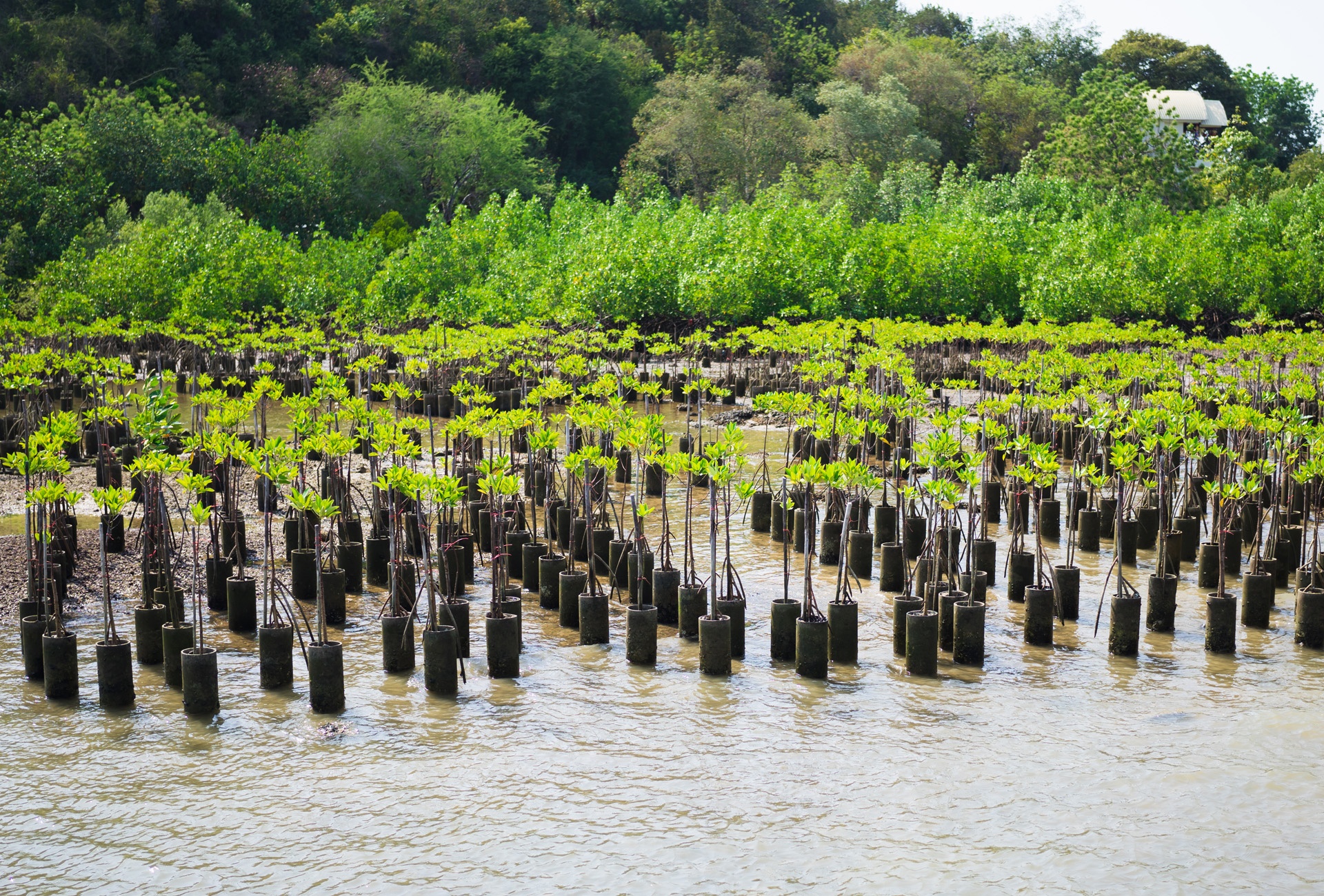
Mangrove nursery
WWF teamed up with Conservation International, the International Union for the Conservation of Nature (IUCN), and The Nature Conservancy to form the Global Mangrove Alliance with the goals:
“Mangroves are a powerful tool that nature has provided us, but we’re not doing enough, fast enough, to protect them,” said Lauren Spurrier, managing director of oceans for WWF.
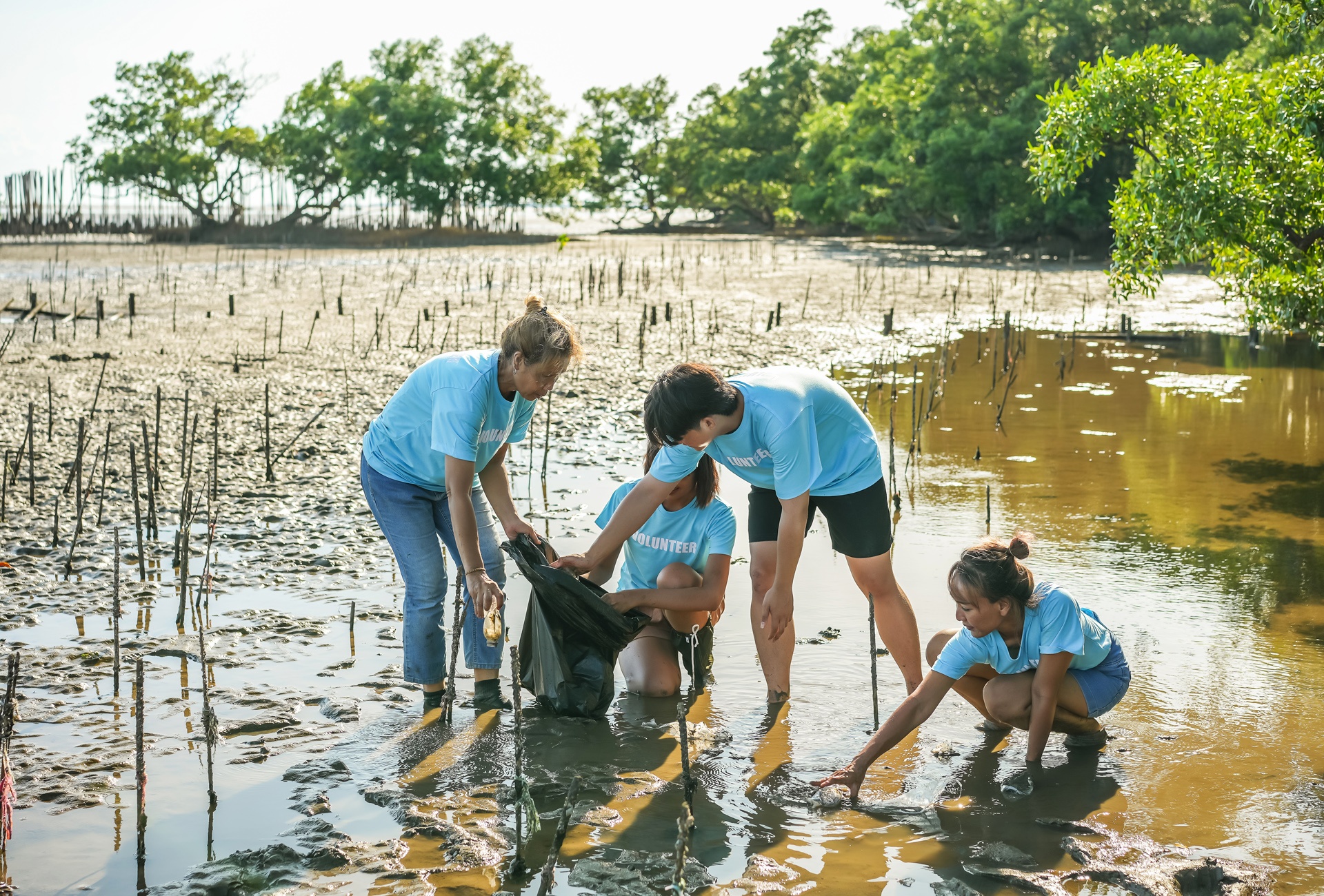
Group of happy volunteers with tree seedlings, Volunteer helpers planting trees in mangrove forest for environmental protection and ecology, reduce global warming, Charity work
The alliance connects funders, experts, policymakers and local communities to accelerate a comprehensive, coordinated, global approach to mangrove conservation and restoration at a scale.
“It will take concerted action by many players to reverse declines and bring back what we’ve lost,” Spurrier said. “There is no time to duplicate efforts and waste resources. Bringing this work together through an alliance, allows us to focus our organizations in areas where we know we can have maximum impact.”
The Global Mangrove Alliance seeks to catalyze $10 billion in investments to improve the resilience of local coastal communities and improve the wellbeing of 10 million people worldwide.

The Public-Private-People Partnerships to Save Coastal Kenya Forests supports sustainable management and conservation of 30,000 hectares of critical mangrove and terrestrial forest ecosystems. The project focuses on mitigating environmental impacts of large-scale economic development by promoting energy and water efficiency while reducing their ecological footprint. It also builds capacity of local communities, government agencies, and the private sector to ensure effective, long-term ecosystem management.
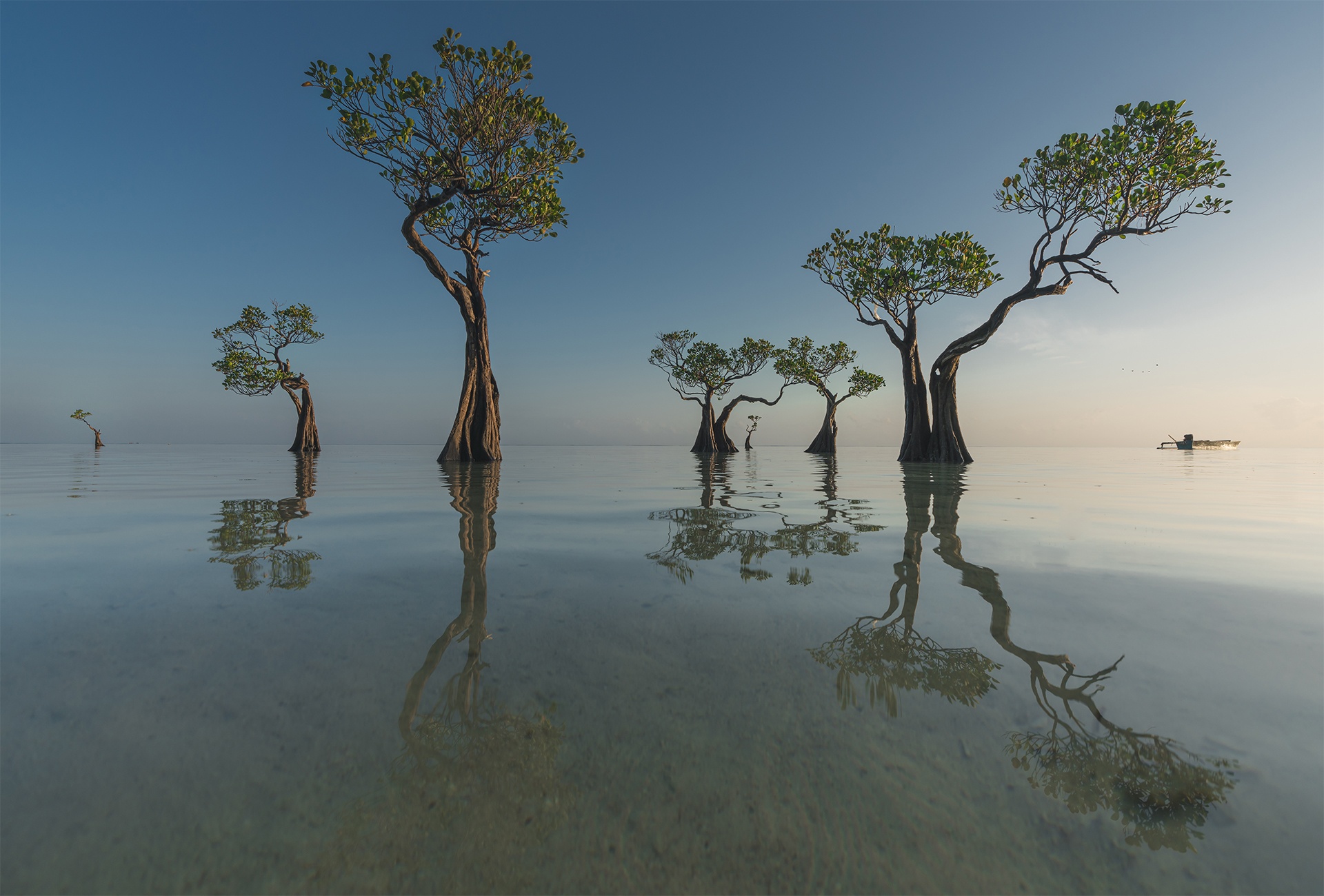
Mangroves, Kenya
One of the key drivers of coastal forest degradation is the lack of information on mangrove ecosystem benefits. Mangroves are essential nesting grounds for fish—a key source of food. They also act to safeguard coastlines against typhoons.
WWF-Kenya’s Public-Private-People Partnerships to Save Coastal Kenya Forests Project focuses on:
This initiative is vital to enhance the resilience of Kenya‘s mangroves, which are crucial for biodiversity and coastal protection.
WWF collaborates with key partners to integrate local knowledge with advanced environmental safeguards. The project also supports global conservation objectives like the Aichi Targets and the Sustainable Development Goals, by embedding ecosystem values into regional policies and development plans, ensuring these ecosystems are preserved for future generations.
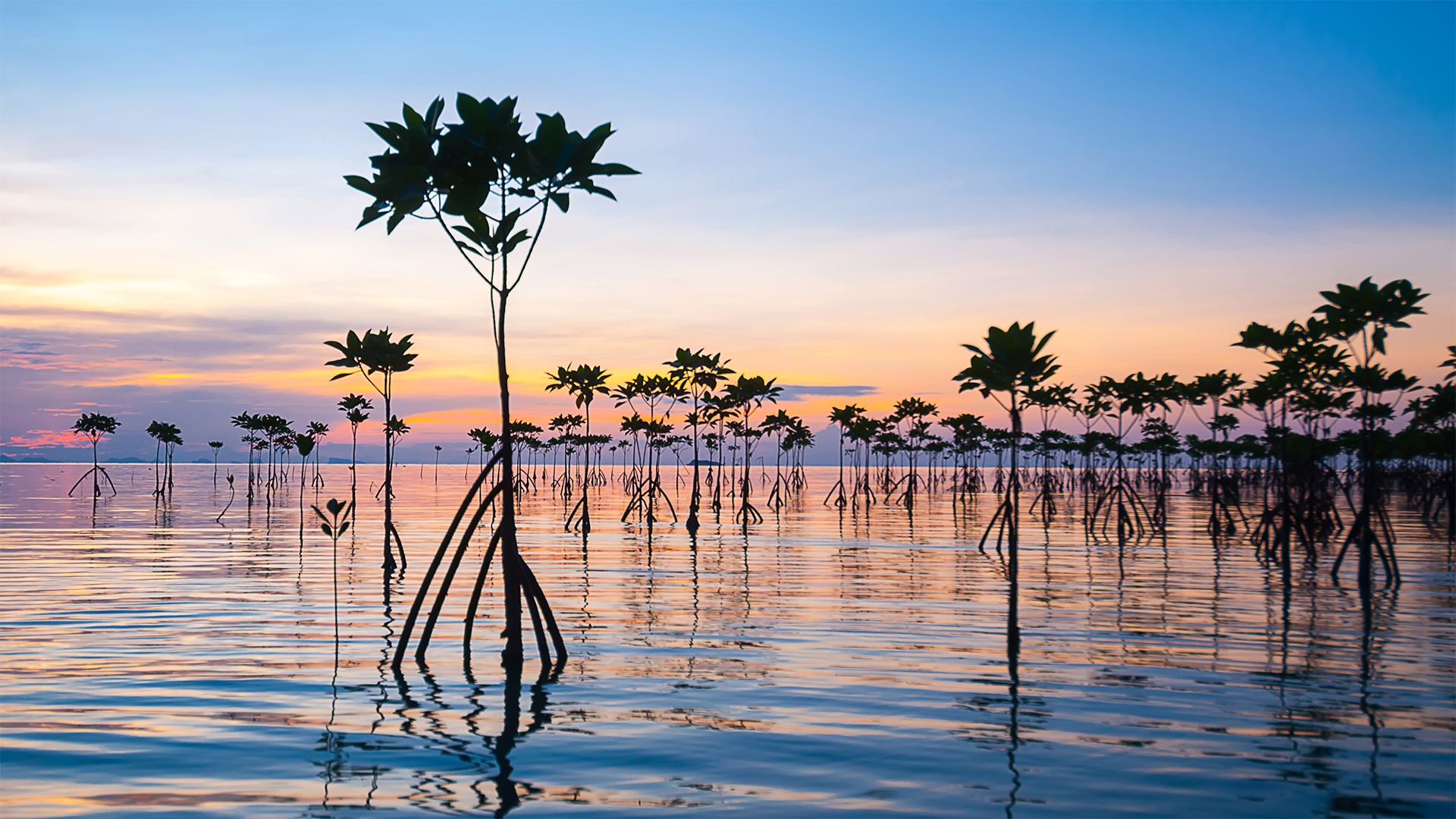
Young mangrove saplings
The Climate-Smart Mangrove Tool is a key part of WWF’s global strategy to bolster mangrove restoration and protection efforts in response to climate change.
The Climate-Smart Mangrove Tool is an advanced predictive tool that provides local communities a step-by-step process for assessing climate vulnerability and selecting climate-smart management actions.
The innovative decision-support tool combines satellite data, climate models, and local knowledge to help conservation practitioners:
The Climate-Smart Mangrove Tool, developed by WWF in partnership with the University of Queensland, has been applied in Colombia, Madagascar, Fiji, and Mexico.
Pinpointing the most viable areas for restoration and conservation, the tool enhances the resilience of vital mangrove ecosystems, essential for preserving biodiversity and supporting coastal communities. The ability to predict and plan for future environmental changes makes the Climate-Smart Mangrove Tool an invaluable resource in the global fight against climate change, supporting both ecological and human coastal resilience.

ManglarIA, supported by WWF and Google.org, uses advanced technologies (LIDAR-equipped drones, eDNA sensors, and automated weather stations) on the Pacific and Gulf coasts of Mexico, particularly within biosphere reserves like Marismas Nacionales, to monitor the health of mangrove ecosystems with unprecedented precision.
The project utilizes AI to analyze vast datasets, predicting the impacts of climate change on these critical ecosystems. This data-driven approach is essential for guiding effective restoration efforts.
In Mexico, WWF is working to protect and restore mangrove ecosystems because of their importance to biodiversity and the contributions they make to local livelihoods and economies. Primary threats to Mexican mangroves include coastal development and climate change. More frequent hurricanes, changing rainfall, and sea level rise all can harm these complex ecosystems and the carbon they store.
By offering detailed insights into how mangroves respond to environmental stresses, ManglarIA (Spanish for “AI for Mangroves”) ensures that local conservation strategies are both impactful and sustainable.
The project also plays a vital role in supporting the resilience of local communities who rely on healthy mangrove ecosystems for their livelihoods. Visit one such community with Nat Hab’s Great Gray Whales of Baja itinerary, when we explore El Vizcaino Biosphere Reserve.

Two percent of the world’s mangroves are found in Madagascar, and 20% of these have been deforested for timber, charcoal production, and agricultural expansion.
In the Nat Hab film below, Expedition Leader Rija Ratotonirinia shares, “The main threat for the animals, for biodiversity in Madagascar, is habitat loss. 90% of our forest is gone due to slash and burn. Slash and burn agriculture is still one of our traditional ways of growing rice.”
Across Madagascar WWF is focused on ecosystem-based disaster risk reduction and supporting alternative livelihoods, so local communities value mangrove ecosystems and do not feel pressure to clearcut for their livelihood or survival. Alternatives to clearcutting include small-scale freshwater fish farming and mangrove beekeeping for honey, as well as ecotourism.
“I wish that we could bring back all of the things like it used to be, but now we have hope. Conservation travel is the best way for Madagascar. We can base part of our economy in tourism because everything we have is unique. Our guests come to Madagascar because we have such a high level of endemism. Biodiversity is so amazing here. We have in Madagascar so many varieties of landscape as well. The local people, they are conscious of this.” Expedition Leader Rija Ratotonirinia
According to Lilia Rasolofomanana, WWF Madagascar’s Mangrove Coordinator, “WWF is now collaborating with… community-based organizations to reinforce the community management of the mangroves, to reduce or even stop the threats to mangroves, to promote climate-smart restoration of this ecosystem and to improve the communities’ livelihoods and resilience to climate change.

If you’d like to witness—and photograph—mangroves, there’s no place on the planet like Madagascar. Ninety percent of Madagascar’s plant, mammal and reptile species are found nowhere else on Earth.
In 2025, Nat Hab launches a new itinerary for its Madagascar Wildlife Photo Expedition, including visits to mangrove ecosystems in both the far north and south of the island:
For over 20 years, Nat Hab and WWF have partnered to offer conservation travel—sustainable travel that supports the protection of nature, wildlife and local communities. Travel has the power to protect nature, benefit communities and preserve cultural heritage in coastal communities where, with WWF’s support, mangroves are being protected, resored, and expanded.

The post 5 Ways WWF is Restoring Mangroves for Climate Resilience & Biodiversity first appeared on Good Nature Travel Blog.
One of my favorite things about travel is the photos I bring home. The walls in my office and our home’s central staircase are covered in framed prints of shots my husband and I have taken around the world—in China, the Cotswolds, Cambodia, the American West and Florida, Morocco, Turkey, Greece, Botswana and Tanzania, all across Switzerland where we live, and so many more places—each comes alive as I glance up from my computer during a busy afternoon or climb the stairs at the end of each day.
One of the ways to ensure I capture the photos I’m anticipating when we travel is to create a well thought out and organized travel photo shot list.
That way, when we’re on the road, I have a checklist at the ready and can easily track my progress. Nat Hab’s India Tiger Photo Expedition has inspired a new shot list for me!

Here are six kinds of iconic shots I’d aim to capture on an Indian wildlife safari:
Old Delhi was founded as a walled city and officially named Shahjahanabad in 1648, when Mughal Emperor Shah Jahan moved the Mughal capital from Agra. Capture the character of centuries of Old Delhi’s complex, multi-layered history on a rickshaw ride and guided walk through the narrow lanes and bustling Chandni Chowk Market.

Explore the architectural treasure of Jama Masjid, India’s largest mosque and Shah Jahan’s magnum opus. Completed in 1656 by more than 5,000 laborers, the grand edifice features alternating vertical strips of red sandstone and white marble, and a vast inner courtyard large enough to hold 25,000 people.

Gurdwara Bangla Sahib is one of the country’s most revered Sikh temples. The complex is associated with Har Krishan, the youngest of the Sikh Gurus, and includes the main temple, school, sacred water tank and large community kitchen that prepares over 10,000 free meals every day. Known as langar, all meals are cooked by volunteers using donated ingredients from Sikh farmers.

Capturing Old Delhi’s complex character is a unique challenge—is it in the people, life on the streets, the architecture? Try capturing movement and energy. Your shots to start the trip may show it in myriad ways.

Tuk-tuk ride, Delhi
Are Bengal tigers on your wildlife photography Bucket List? In the renowned tiger enclave of Ranthambore National Park, when the Indian spring moves toward the hotter months, animals anticipate the monsoon still weeks away.
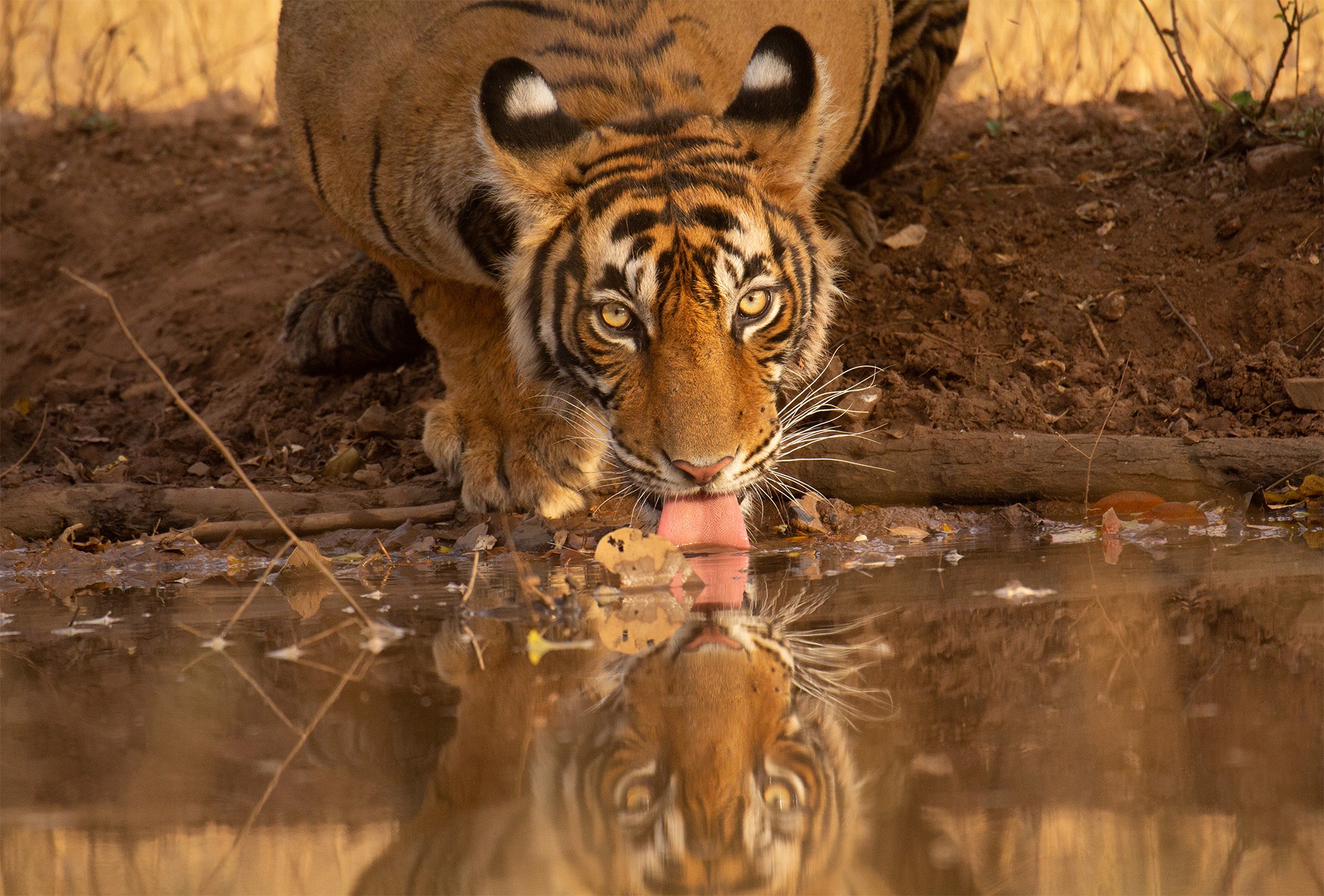
Nat Hab Expedition Leader © Conan Dumenil
During the heat of the day, tigers seek shelter, but they emerge to feed and drink, moving from the dry underbrush into the open at least twice a day—that’s the time to capture your next iconic shot!
With over 3,680 individuals, India is home to 75% of the world’s tiger population. Will you capture an iconic shot of one—or more—of them? Is a direct gaze on your shot list? A close up of the pattern of a tiger’s stripes? The slow amble of a tiger in the heat of day?

Nat Hab Expedition Leader © Surya Ramachandran
The Ranthambore Tiger Reserve, declared a National Park in 1980, is one of the largest tiger habitats in the country. A former royal hunting ground, it now supports a population of 80 tigers in a dry deciduous forest located between two mountain ranges, Aravalli and Vindhya.
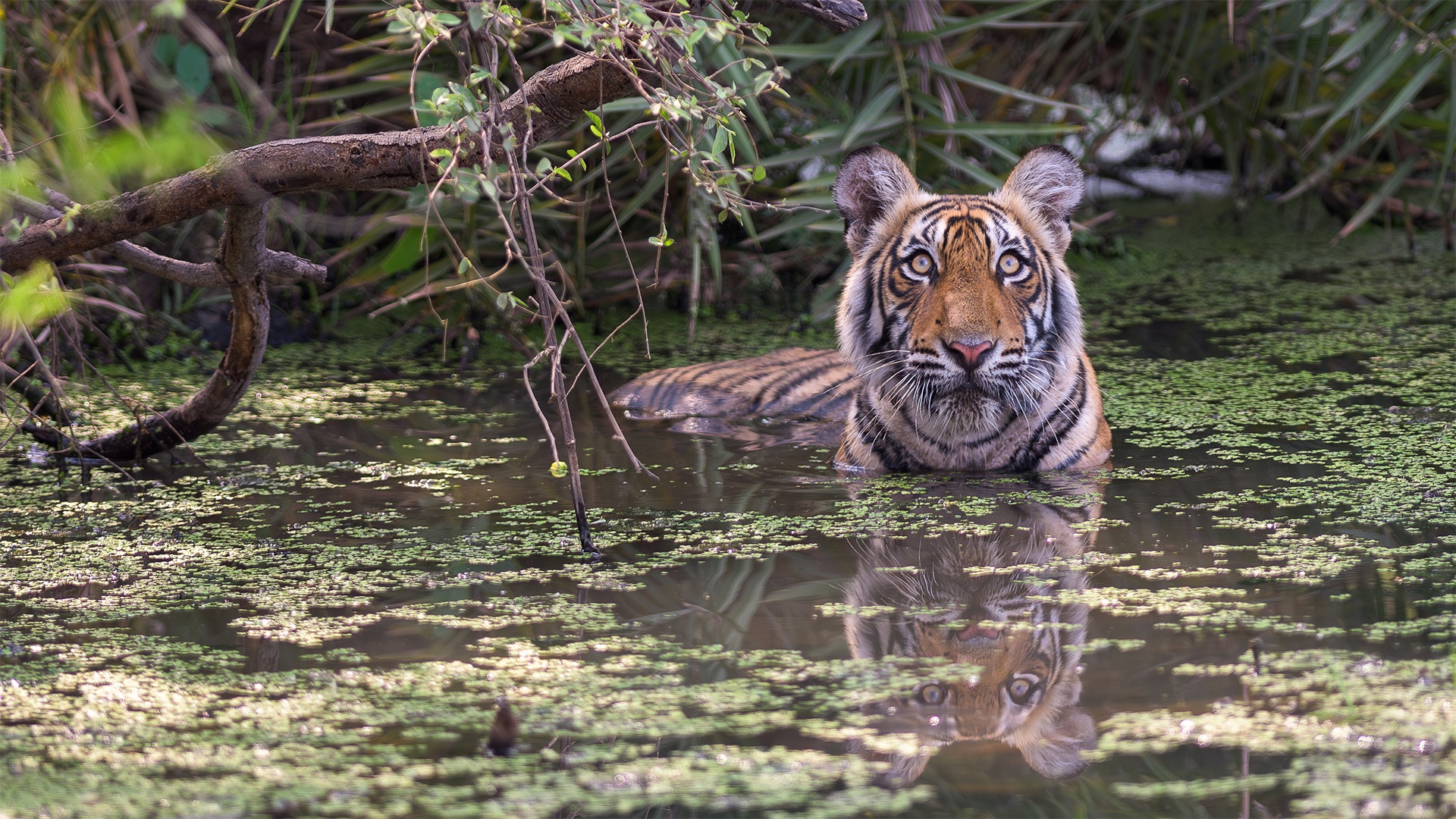
Nat Hab Expedition Leader © Aditya Panda
The foundations for Ranthambore Fort were laid by King Sapaldaksha of the Chauhan Dynasty in 944 AD, and it was added to by successive rulers. It’s a vast, crumbling complex of picturesque ruins of palaces, temples and courtyards which now make unique habitat, providing shade and shelter for the animals—and beautiful backdrops.
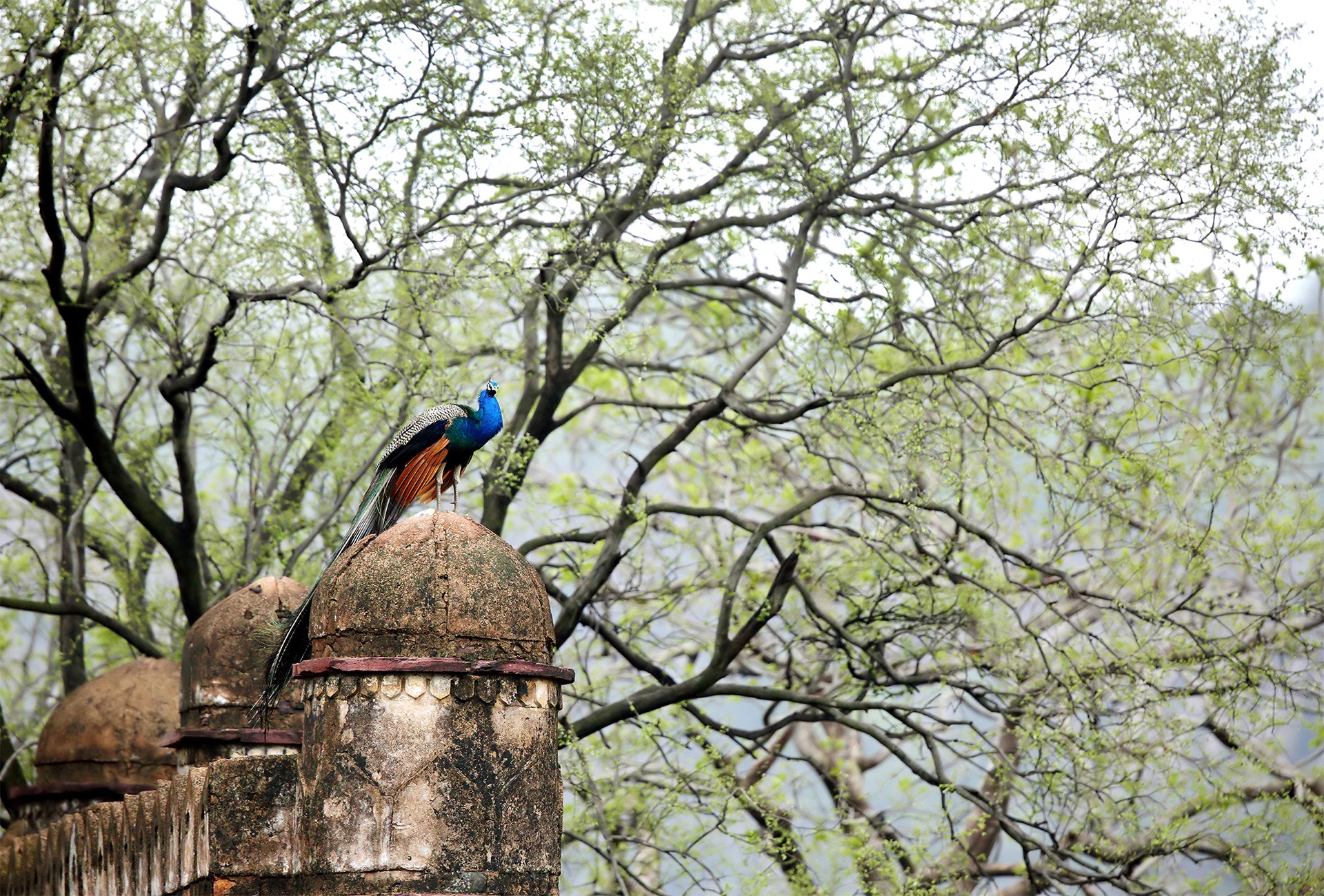
Peacock, Ranthambore Fort
In India, the 1972 tiger census revealed the existence of only 1,827 tigers, prompting Indira Gandhi to enact significant wildlife protections, including the creation of core areas, such as Ranthambore National Park, isolated from human encroachment. The surrounding areas were to be made into buffer zones, where animals and humans can coexist, and where activities such as ecotourism and sustainable agriculture can take place.
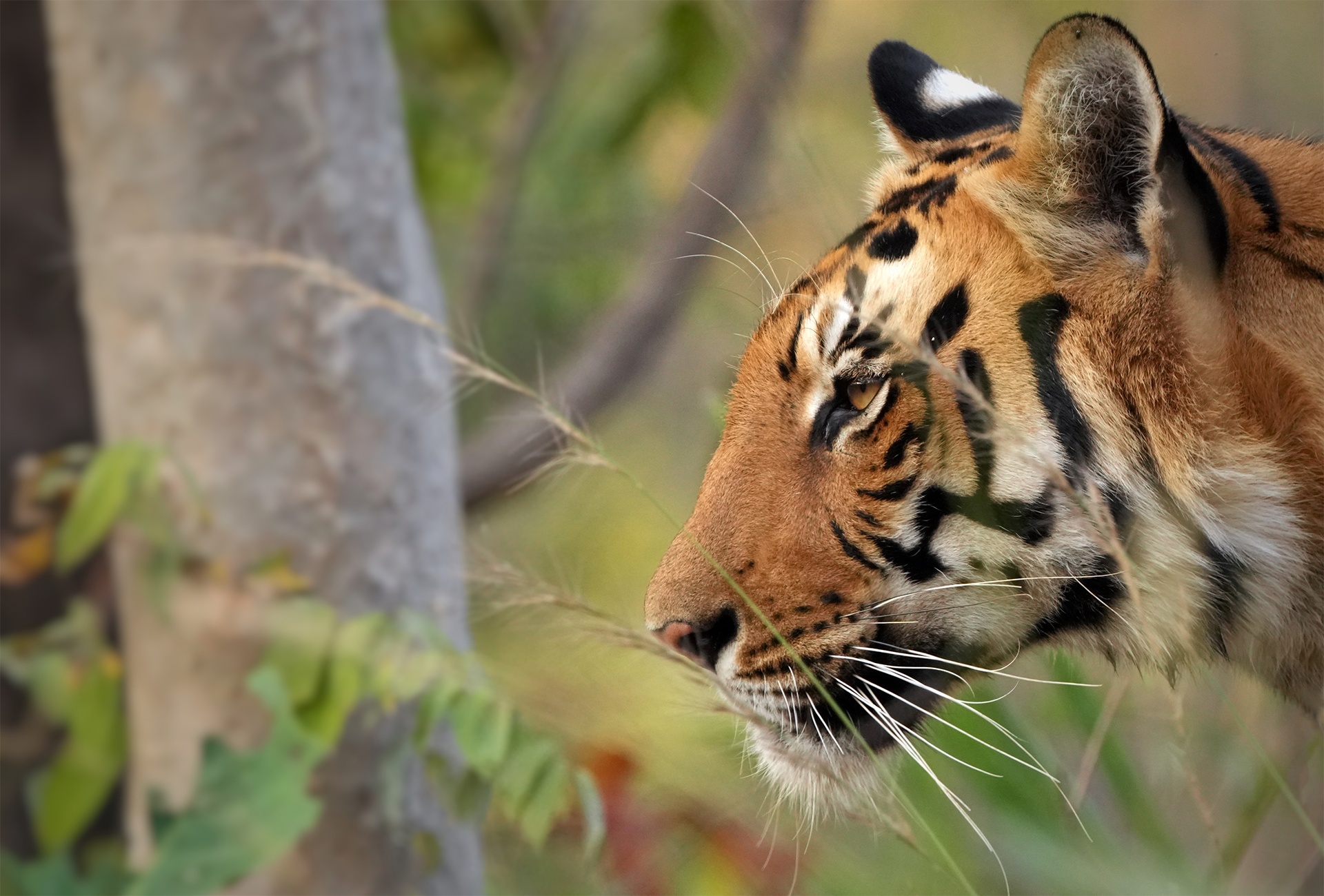
Nat Hab Expedition Leader © Surya Ramachandran
Early morning and late afternoon safaris provide the best light for photographing the tigers of Ranthambore, with golden hues streaming through the trees. As the tigers move through the dense jungle, stealthily approach a waterhole or take cover under dense brush, be prepared to switch between wide shots capturing their environment and close-ups that convey the intensity in their gaze.
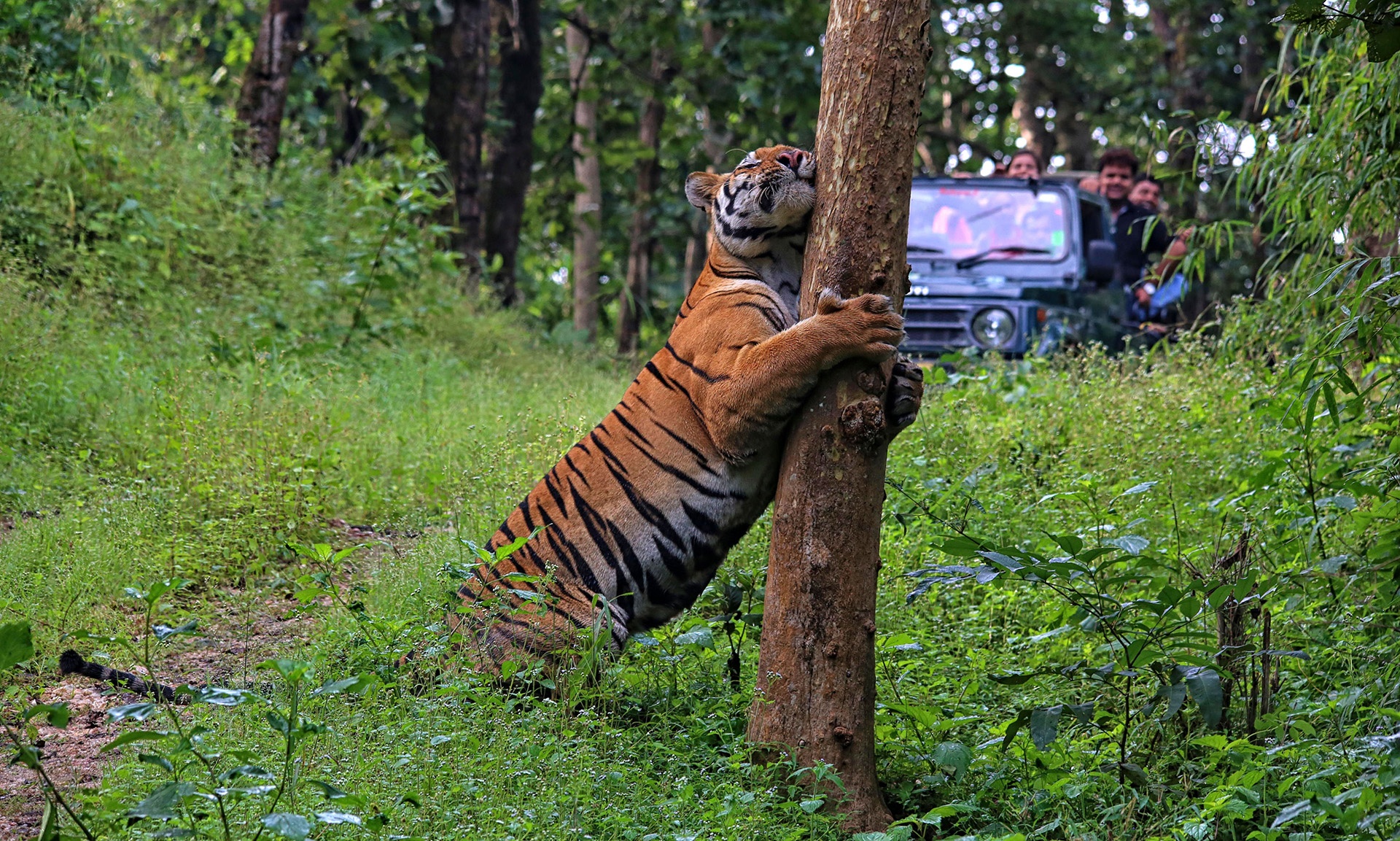
Nat Hab travelers spy a tree-hugging tiger on their wildlife safari in India © Surya Ramachandran
The park’s rocky terrain and ancient ruins add a mystical element, enhancing the drama of the shot—be on the lookout for seven different cat species! Ranthambore is also home to a notable leopard population, although they tend to stay in higher, more inaccessible areas and are not frequently visible.
Tigers may be your main focus, but other wildlife is plentiful. Sightings may include spotted deer, nilgai, jackal, jungle cat, sloth bear, sambar, chinkara gazelle, wild boar, langur monkeys and rhesus macaques.
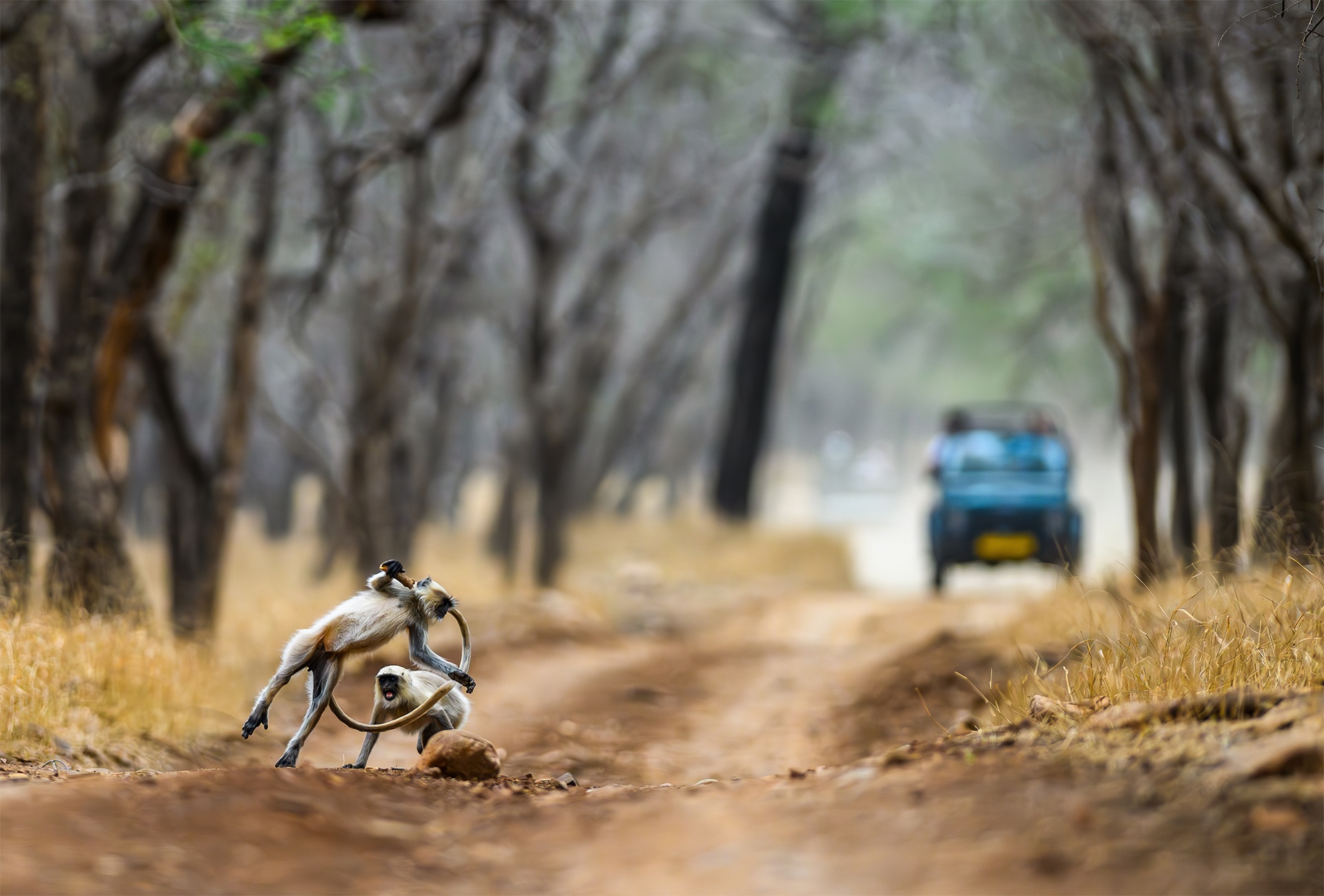
Langur monkeys playing in Ranthambore National Park
One of the most iconic wildlife shots to capture on an Indian tiger photo expedition is of the Bengal tigers of Ranthambore National Park.
The Taj Mahal, one of the world’s most photographed landmarks, reveals its true splendor at sunrise and sunset. Sunrise bathes the marble in a soft, pinkish glow, while sunset offers a warm, golden light that contrasts with the rich blue and orange hues of the sky.
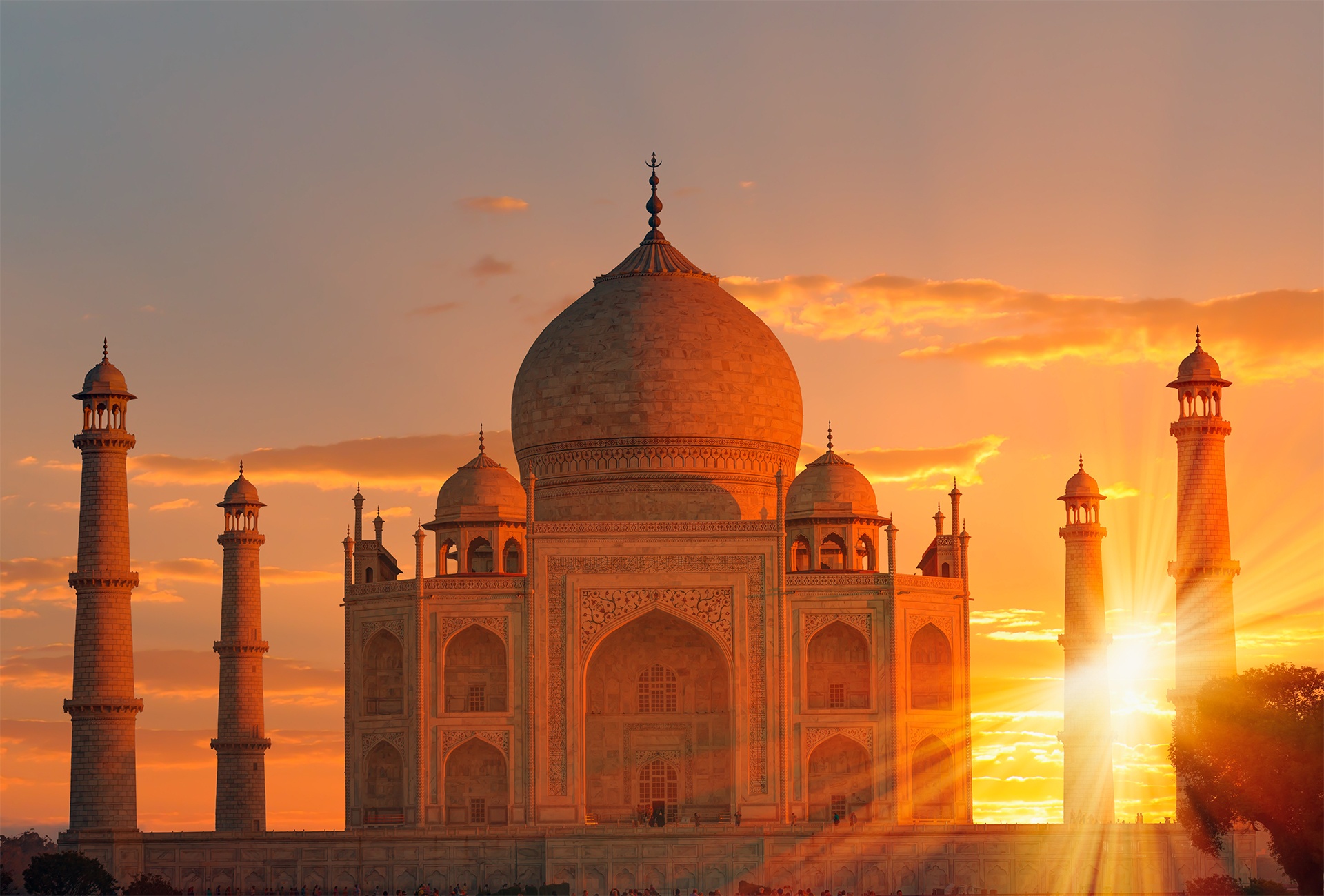
Taj Mahal
The Taj was commissioned in 1632 by the Mughal emperor, Shah Jahan, as a testimony of his intense love for his wife Mumtaz Mahal. It is a romance celebrated in marble and glorified with precious and semi-precious stones.
To capture the intricate beauty of the Taj Mahal, play with reflections on the still waters of the surrounding pools. For a fresh perspective, shift your composition, from wide-angle shots capturing the full scope of the monument to tighter compositions focusing on architectural details like the floral inlays or the delicate symmetry of its arches.
What kinds of images do you hope to capture at the Taj Mahal? Do you want to tell a love story in images? Evoke its sense of tranquility and reverence? Capture details you’ve never seen in others’ photos from the same place.

Taj Mahal
Tigers may be the stars of this photo expedition, but the private Jhalana Leopard Reserve offers a thrilling opportunity to photograph leopard adults and cubs.
Known for their stealth and ability to vanish into the landscape, leopards are an elegant, elusive subject. The Jhalana Leopard Reserve offers one of the best opportunities in India to photograph leopards engaged in their routine activities and natural habitat.
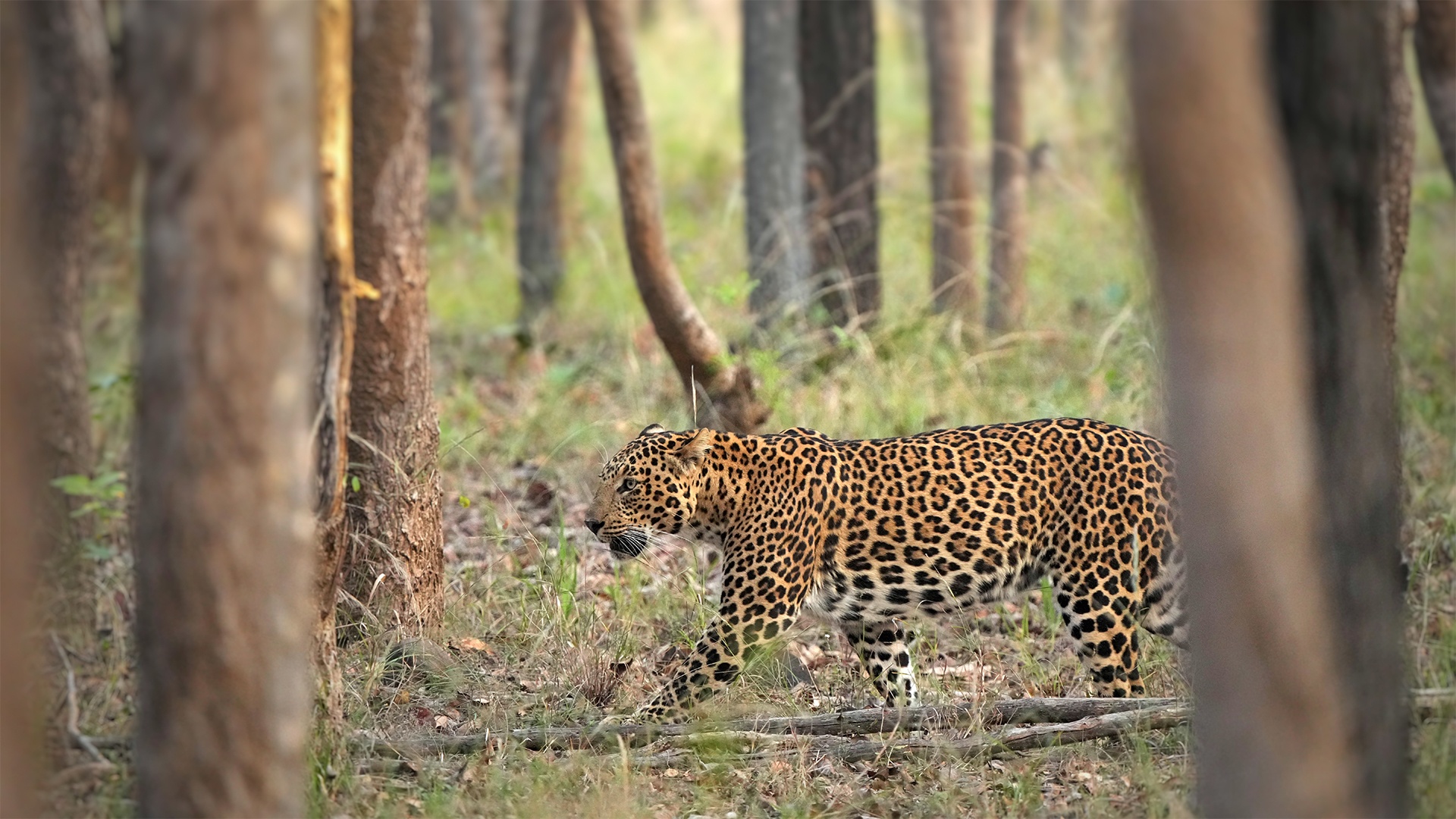
Leopard photographed by Nat Hab Expedition Leader © Surya Ramachandran
Jhalana is the world’s most densely populated leopard reserve, which nearly guaratees a sighting. With leopards, lighting is everything—dappled light filtering through trees creates powerful contrasts, highlighting the golden tones of their fur against shadowy branches and brush.
Photographing a leopard is another iconic shot on an Indian tiger safari or Indian tiger photo expedition.
The Jhalana forest is a dry deciduous forest, dominated by the sloping valleys and sharp cliffs of the Aravalli hills. The forest features plants that thrive in arid conditions like juliflora and khejri, the state tree of Rajasthan.
In addition to leopards, you might spot—and capture shots of—a variety of other animals: striped hyenas, Indian civets, desert foxes, jackals, porcupines, monitor lizards, mongooses, sambar deer, spotted deer, and blue bull.
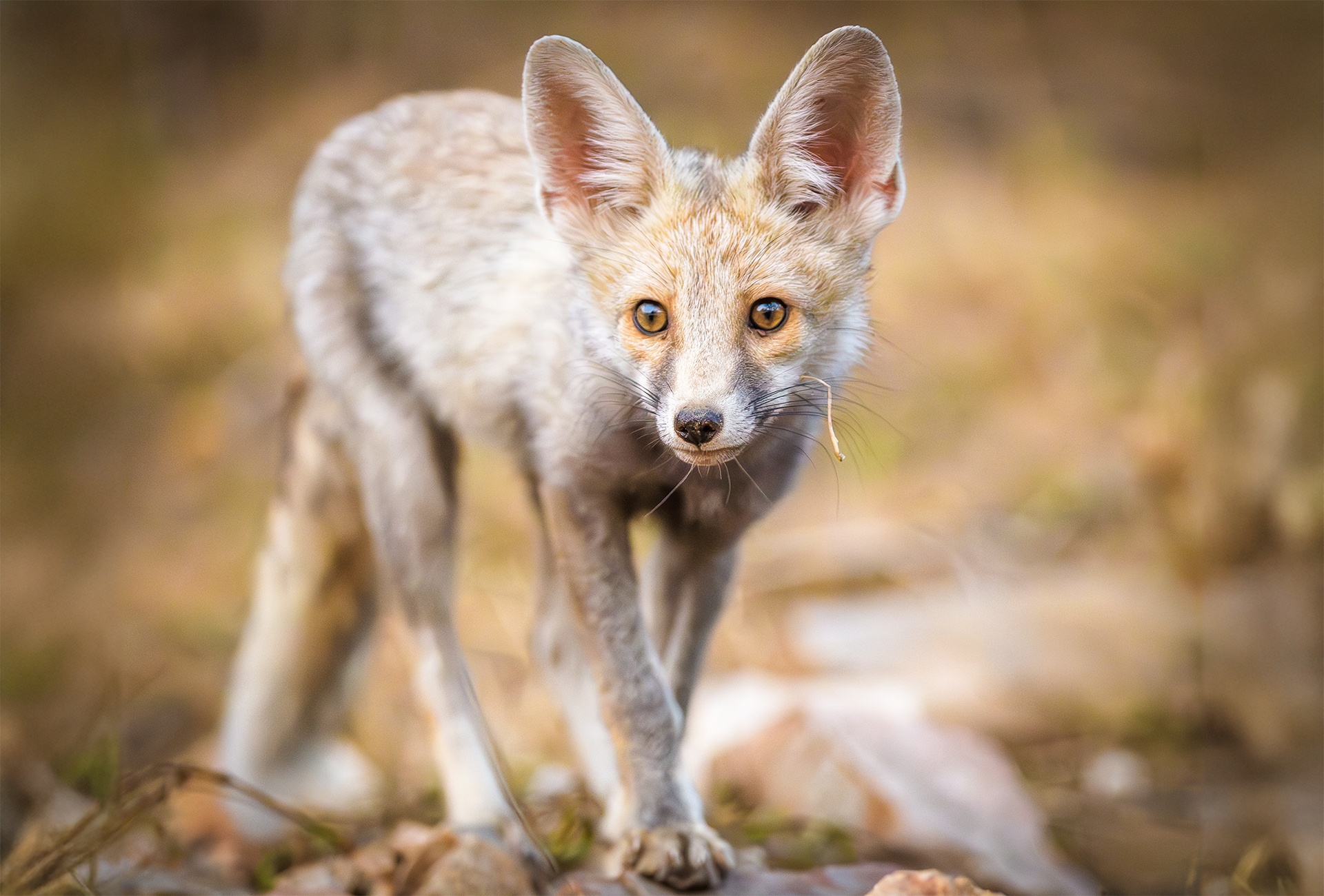
Fox, photographed by Nat Hab Expedition Leader © Aditya Panda
Northern India is a paradise for bird enthusiasts, offering the chance to capture a range of colorful avian species in their natural habitat.
From Indian peafowl displaying their iridescent tail feathers to crested serpent eagles soaring overhead, this environment offers endless opportunities for avian photography. Experiment with fast shutter speeds to capture birds in flight, or slow it down for graceful shots of waterfowl on tranquil lakes.
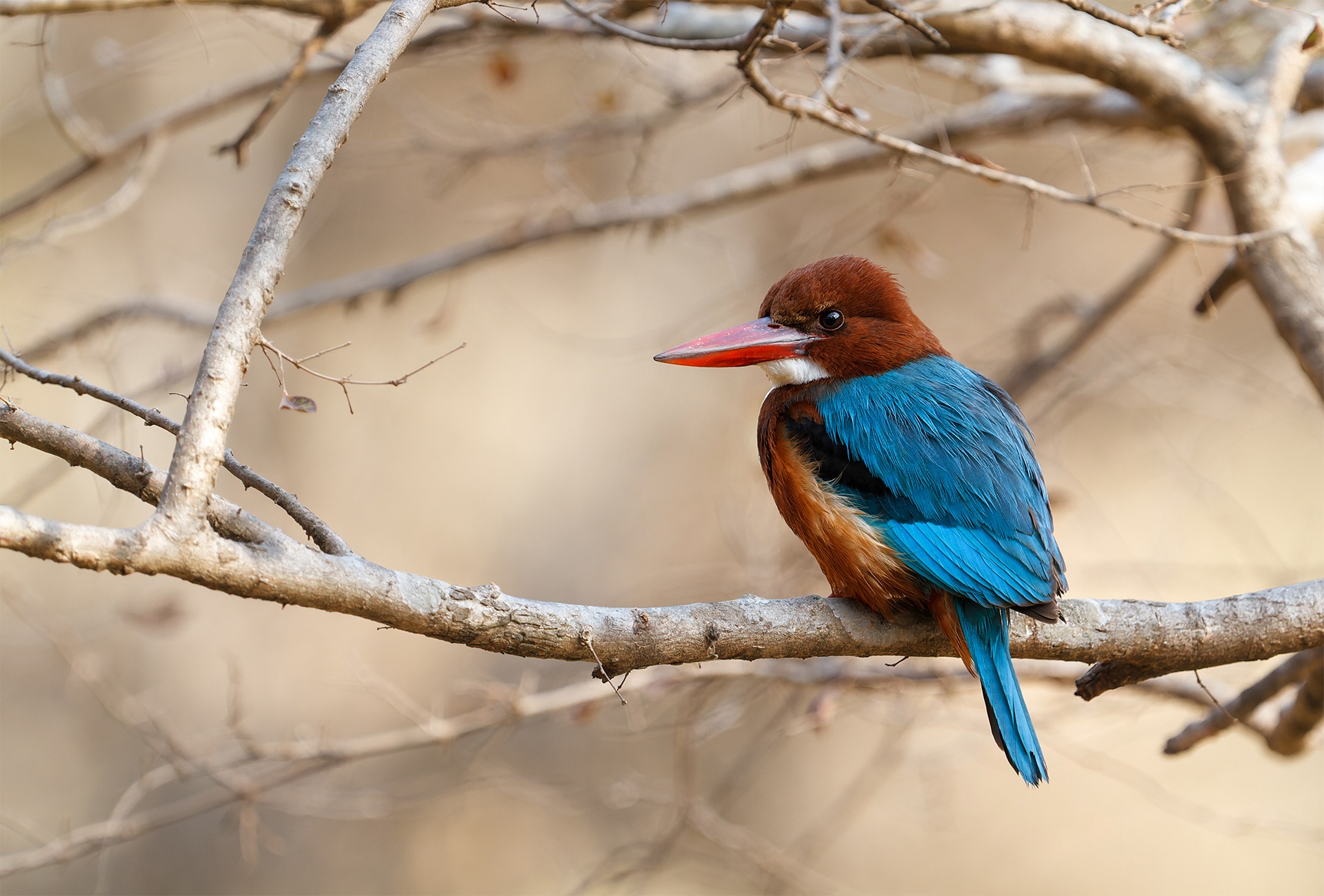
White-throated Kingfisher
Iconic kingfishers, with their vivid blues and oranges, provide striking contrasts against the earthy tones of the forest. Photographs of birds perched against the dramatic backdrop of Ranthambore’s ancient ruins add a timeless quality to your shots.
Over 300 avian species, both migratory and endemic, might also pose for photos in Ranthambore National Park. Keep an eye out for paradise flycatchers, painted storks—you may hear the peacocks before you spot them.
Jhalana Leopard Reserve hosts hundreds of bird species, too. According to Cornell University’s Lab of Ornithology eBird platform, over 225 species have been spotted in and around the Jhalana Leopard Reserve.
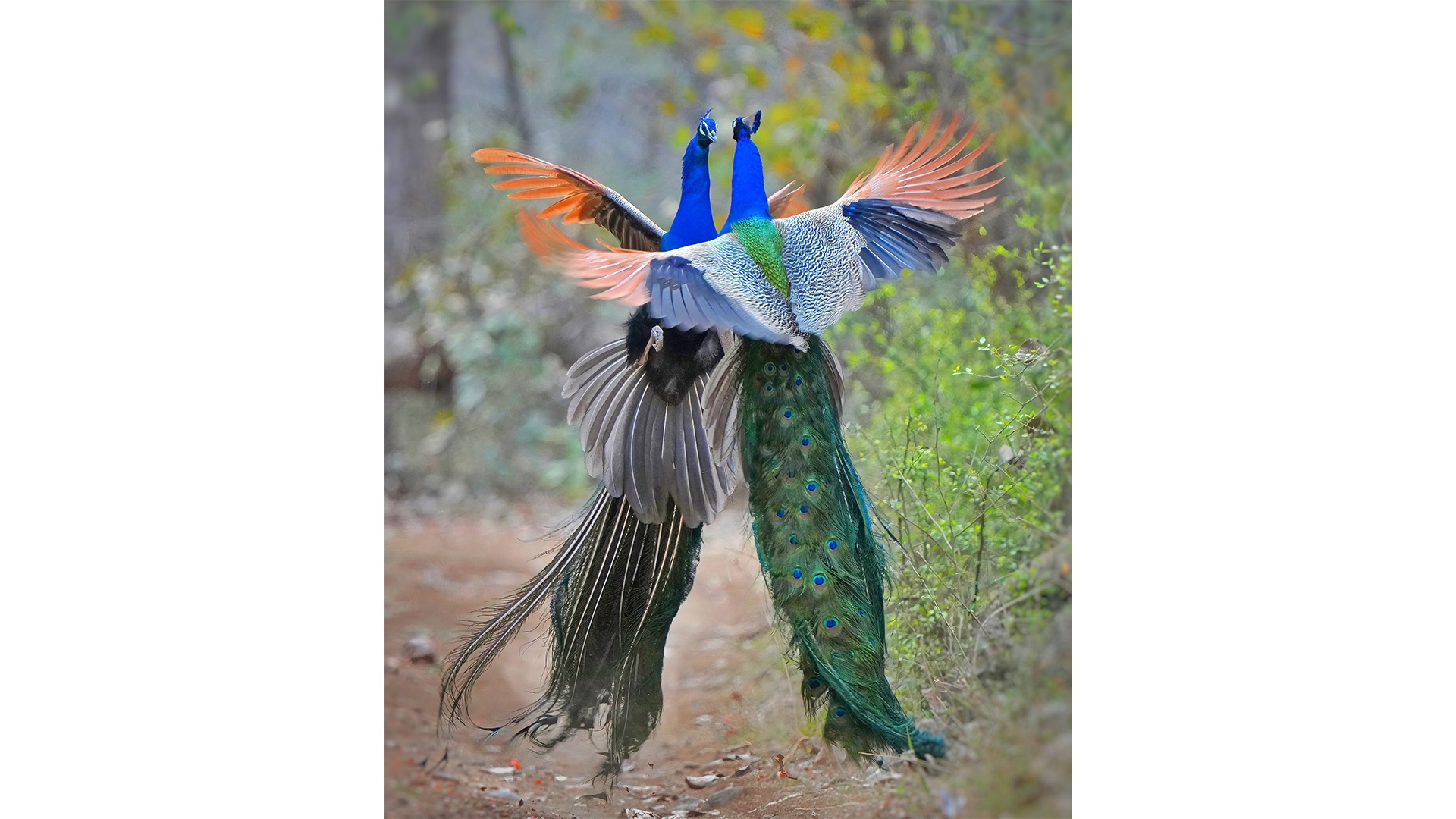
Nat Hab Expedition Leader © Surya Ramachandran
Nat Hab’s Director of Photo Expeditions, Mike Hillman, is an award-winning birder, too, so I asked him for tips on photographing birds in India. Here are 4 ideas you can practice right away. He shared:
While your trip may focus on wildlife, no photographer can resist the vibrant energy of Jaipur’s Pink City, where centuries-old architecture meets the hustle and bustle of daily life. Jaipur is a visual delight, offering endless photography opportunities.
Capture the intricate details of the Hawa Mahal, with its hundreds of windows and coral-hued facade, or focus on the contrast between the ornate palaces and the vibrant markets below.
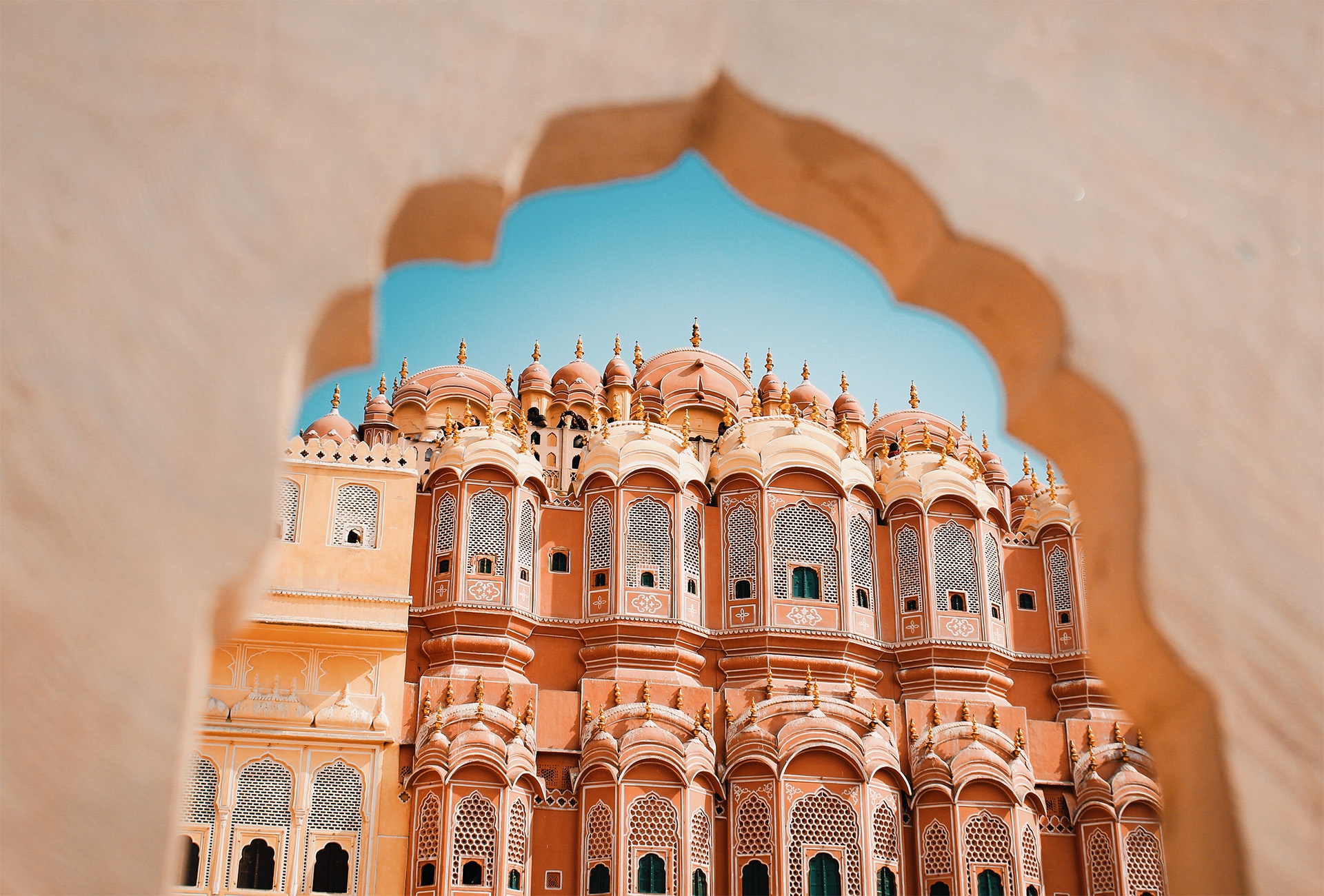
Jaipur: The Pink City
Wide-angle shots of the cityscape at sunrise or sunset provide a breathtaking view of this desert city bathed in warm light. Street photography comes alive here—capture the essence of local culture through portraits of artisans, colorful fabrics, and market scenes. The interplay of shadow and light in Jaipur’s narrow lanes adds a dramatic flair to your images, reflecting the dynamic contrast between old-world charm and modern life.
Survey it on a morning open rickshaw tour. Jaipur’s sprawling bazaars draw locals arriving in their own rickshaws and camel-drawn carts, shopping for a dazzling array of goods, from carpets and camel leather bags to precious stones and textiles. Bags of spices perfume the air, and huge metal pots simmer with pungent curries.
The Govind Dev Ji temple, at the heart of the city palace complex, is another highlight. Devoted to Lord Krishna, the Hindu temple is one of the most important religious and cultural sites in the daily lives of locals. Take a short walk through the palace garden to reach the busy farmers market and flower market where turbaned traders sell sacks of roses and marigolds.
How will you capture the energy and agelessness of Jaipur?
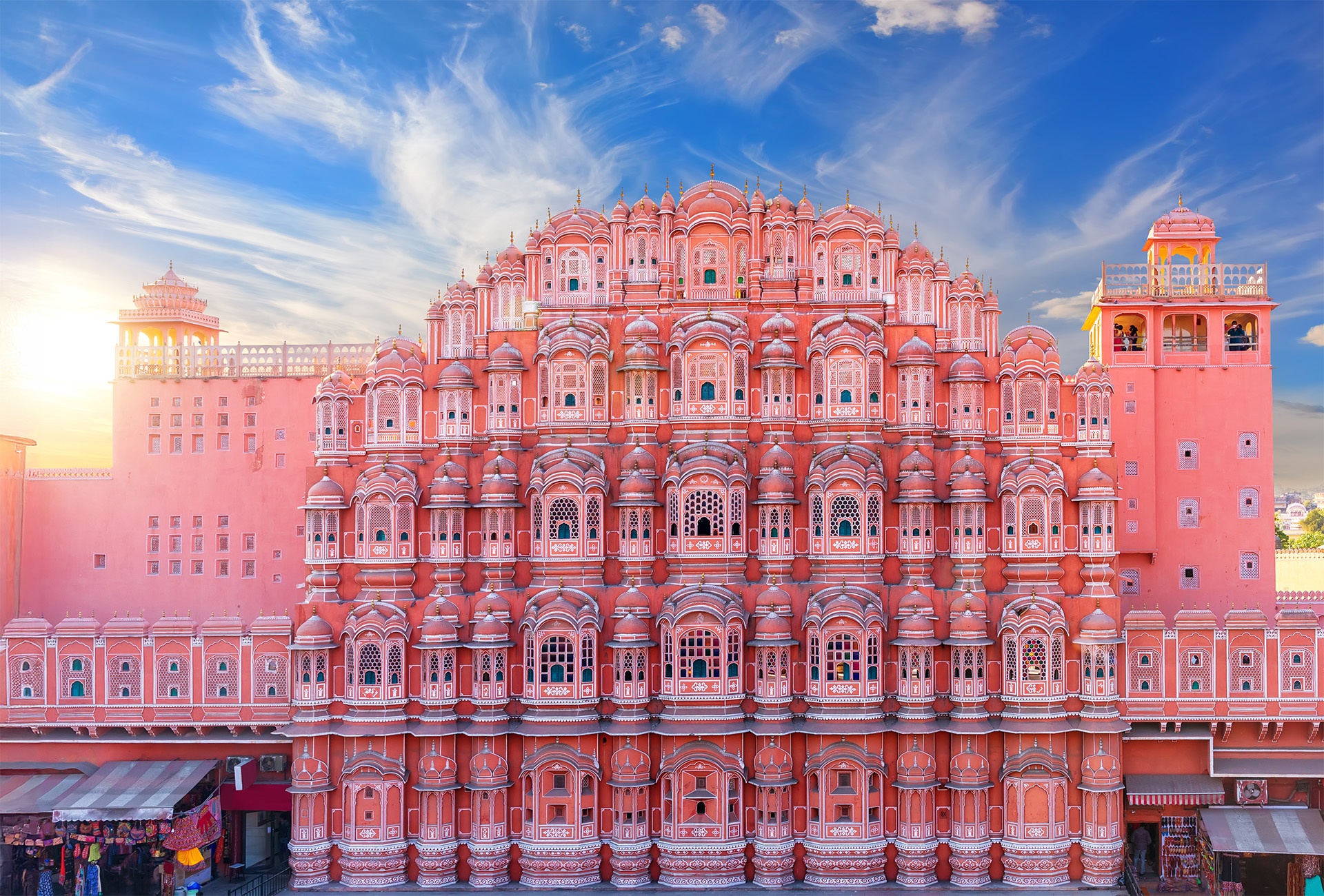
Jaipur: The Pink City
What iconic shots of India’s wildlife and colorful culture will you want to be sure to capture? Put them on your own shot list. Each one offers its own unique challenges and rewards, and will enrich your photographic portfolio and create lasting memories of India’s vibrant wildlife, iconic landscapes, and rich cultural heritage.
Each of these six kinds of iconic travel photos is an opportunity to capture not just an image, but the story and spirit of northern India.
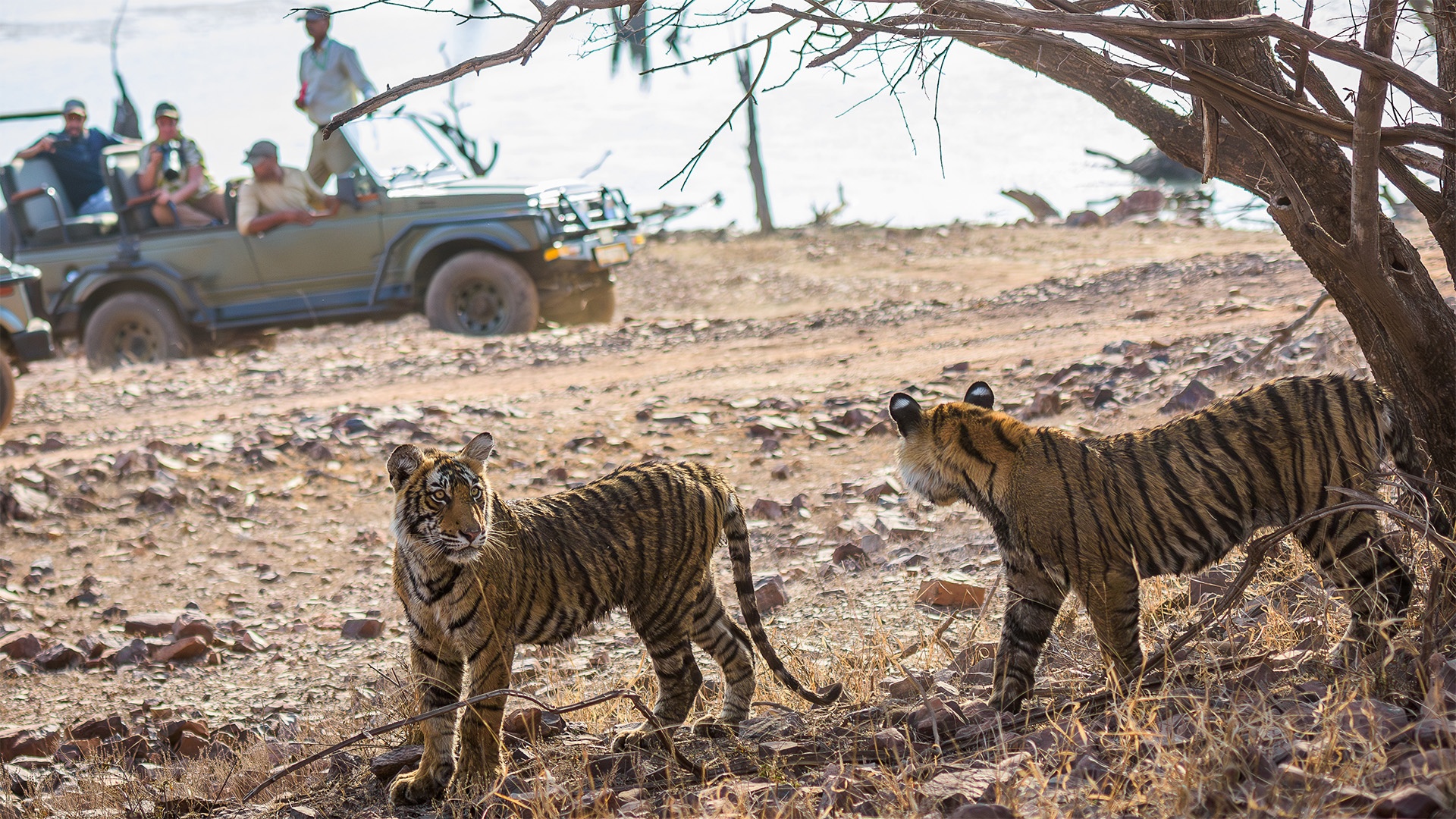
Nat Hab Expedition Leader © Aditya Panda
Don’t Forget to check out the resources, tips and guides on our Know Before You Go and Videos & Webinar pages.
In How to Shoot Timeless Wildlife Photography in Black and White, a Daily Dose of Nature video, Nat Hab India Photo Expedition Leader Aditya Panda answers important photo questions:
In Post-Processing Wildlife Photos in Black & White, Panda demonstrates how to post-process your color wildlife photographs and convert them to black and white.
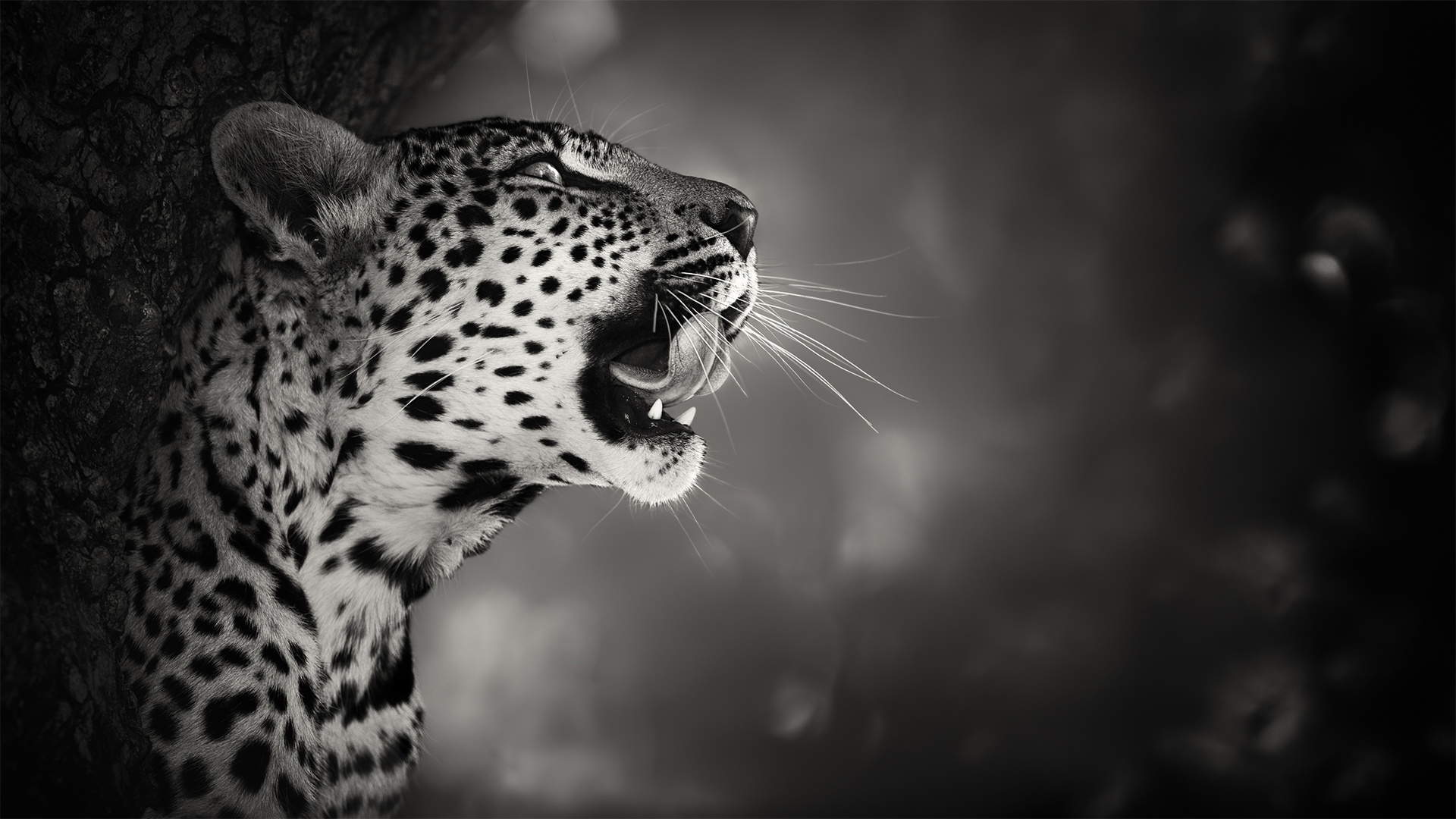
Leopard
The post 6 Iconic Shots to Capture on an India Tiger Photo Expedition first appeared on Good Nature Travel Blog.
The World’s Leading Nature Travel Company Announces More Than 30 Specialized Photography Tours Led by Expert Photographers
Boulder, CO, November 4, 2024 – Natural Habitat Adventures (Nat Hab), the leading conservation travel company in partnership with World Wildlife Fund (WWF), today unveils a new and updated collection of photography-focused trips: Photo Expeditions.
Building on its 40 years of experience that includes crafting journeys for photographers, Nat Hab has reimagined its Photo Expeditions with a more in-depth educational approach to nature photography. This newly curated lineup offers more than 30 expertly designed itineraries, each tailored to meet the growing demand for specialized photography experiences in some of the world’s most breathtaking natural environments.
“Witnessing wildlife in its natural habitat is a remarkable experience, but capturing those moments through a lens — whether it’s a lion on the hunt or butterflies in mid-flight —transforms the adventure into something even more meaningful,” says Ben Bressler, Founder and CEO of Natural Habitat Adventures.
“Guided by top photographer Expedition Leaders who are masters of their craft as well as professional naturalists, travelers on a Photo Expedition will learn how to take those epic photographs by gaining insight into wildlife movements and behavior. They will also benefit from technique and editing tutorials. As WWF’s conservation travel partner, we hope the power of photography creates a deeper connection with nature, inspiring our travelers to share their experiences and advocate for the protection of our planet.”
The expanded line-up of photo tours comes in response to rising demand, says Bressler. The company’s Photo Expedition bookings for 2025 are up 21% over 2024, and this year also represents increased bookings over 2023. “We want to serve nature photographers with the most immersive itineraries and best guides.”
Each Photo Expedition is led by a Nat Hab Expedition Leader who is both an accomplished professional photographer and a seasoned naturalist with extensive knowledge of wildlife habitats, behaviors, and movement patterns—enabling, guests to capture high-quality images through an understanding of animals and their habitats.

Tailored instruction is provided for all skill levels and equipment, from DSLRs to smartphones, creating a personalized learning experience for every participant. Travelers will have the opportunity to enhance their photography talent and fine-tune their editing skills through guided presentations and workshops. These sessions cover essential tips for capturing stunning images, including in challenging conditions such as night, desert glare, rainforest shadows, or snow and ice.
Photo Expeditions provide an optimal context for getting the best possible wildlife and landscape images. Itineraries feature secluded and remote locations away from crowded tourist areas, offering guests the quiet, intimate setting necessary for capturing coveted shots. With small groups averaging just six to nine guests, the schedule is flexible, allowing the group to move to where wildlife is, and to linger in pursuit of the best light.
Some Photo Expeditions offer additional baggage allowance for photography gear, which can be crucial on an African safari. All guests have window seats or full rows in a vehicle for optimal shooting, including on boats and aircraft. Accommodations are carefully selected for their proximity to key photography spots, from mobile safari camps along Africa’s Great Migration route to secluded bases in Greenland and Alaska’s Lake Clark National Park.
More than 30 Photo Expeditions are now available across North America, Africa, Asia, Latin America, and Northern Europe. See some of the top trips below:
Other Photo Expeditions include jaguars in Brazil, the monarch butterfly migration in Mexico, glaciers in Patagonia, unique wildlife in the Galapagos, and much more. See all Photo Expeditions. Learn more about Nat Hab’s accomplished Photo Expedition Leaders.
##
About Natural Habitat Adventures
Natural Habitat Adventures has been a trailblazer in sustainable and conservation-focused adventure travel since 1985. Led by professional naturalist guides, Nat Hab journeys reveal the planet’s most extraordinary nature destinations, including polar bear tours in Churchill, small-group Galapagos cruises, intimate African safaris, close encounters with Alaskan brown bears, wolf quests in Yellowstone, and much more. As the world’s first 100% carbon-neutral travel company, creator of the World’s First Zero Waste Adventure, and the conservation travel partner of World Wildlife Fund since 2003, Nat Hab offers nearly 100 eco-conscious nature adventures from Antarctica to Zimbabwe and beyond. Featuring unique and artfully crafted itineraries, Nat Hab trips demonstrate how conservation travel works with and benefits local communities, furthering a shared commitment to conservation. Nat Hab actively seeks ways tourism can lower its impact on the planet while raising global citizens’ appreciation for the wonders of nature. For more information, visit nathab.com.
The post Natural Habitat Adventures Announces New Photo Expeditions Collection first appeared on Good Nature Travel Blog.
In 2001, WWF declared the Iberian lynx (Lynx pardinus) “the most endangered cat species and the only endemic large carnivore in Europe.”
At the time, the situation for the Iberian lynx was dire: They were found in just a handful of isolated pockets of Spain and Portugal, and the International Union for Conservation of Nature (IUCN) estimated the population had dwindled to just 62 mature individuals.
Populations had declined from 15 subpopulations in the 1940s to only two subpopulations in the early 1990s. The species had experienced an 80% range loss between 1960 and 1990. By 1980, the Portuguese lynx population was estimated at no more than 50 individuals.
Today, the Iberian lynx population, including young and mature cats, is estimated to be more than 2,000. As a result, in June 2024, the IUCN removed the Iberian lynx from the Endangered list, upgrading its status to Vulnerable.
This article explores the journey of the Iberian lynx from near extinction to a conservation success story, highlighting key actions, challenges and prospects. WWF plays a critical role in those efforts.

In the early 19th century, thousands of Iberian lynx inhabited Spain, Portugal and Southern France. Fossils suggest the species has been present in Iberia since the end of the Early Pleistocene, around one million years ago, and that its range has extended far into France and Italy.
An adult Iberian lynx is heavily spotted, weighs 22–29 pounds, and has long legs and a very short tail with a black tip.
Female lynxes generally give birth in March and April. The average litter size is 3, but it is rare for 3 Iberian lynx cubs to survive weaning—mortality rates are high. Kits become independent at 7 to 10 months old but remain with the mother until around 20 months old. The survival of the young depends heavily on the availability of prey species.
The Iberian lynx depends heavily on wild rabbits to feed, but it will also eat ducks, young deer and partridges if rabbit densities are low. An adult lynx needs about one rabbit per day; a mother raising lynx kits might need three.
Iberian lynx prefer open grassland mixed with dense shrubs such as strawberry tree, mastic, and juniper, and trees such as holm oak and cork oak and mark their territory with urine, scratch marks on the barks of trees, and scat.
Adult home ranges remain stable over many years. Camera trap surveys in the eastern Sierra Morena Mountains between 1999 and 2008 revealed that six females had home ranges of 2-2.5 square miles, and four males had home ranges of 4.6-4.7 square miles.
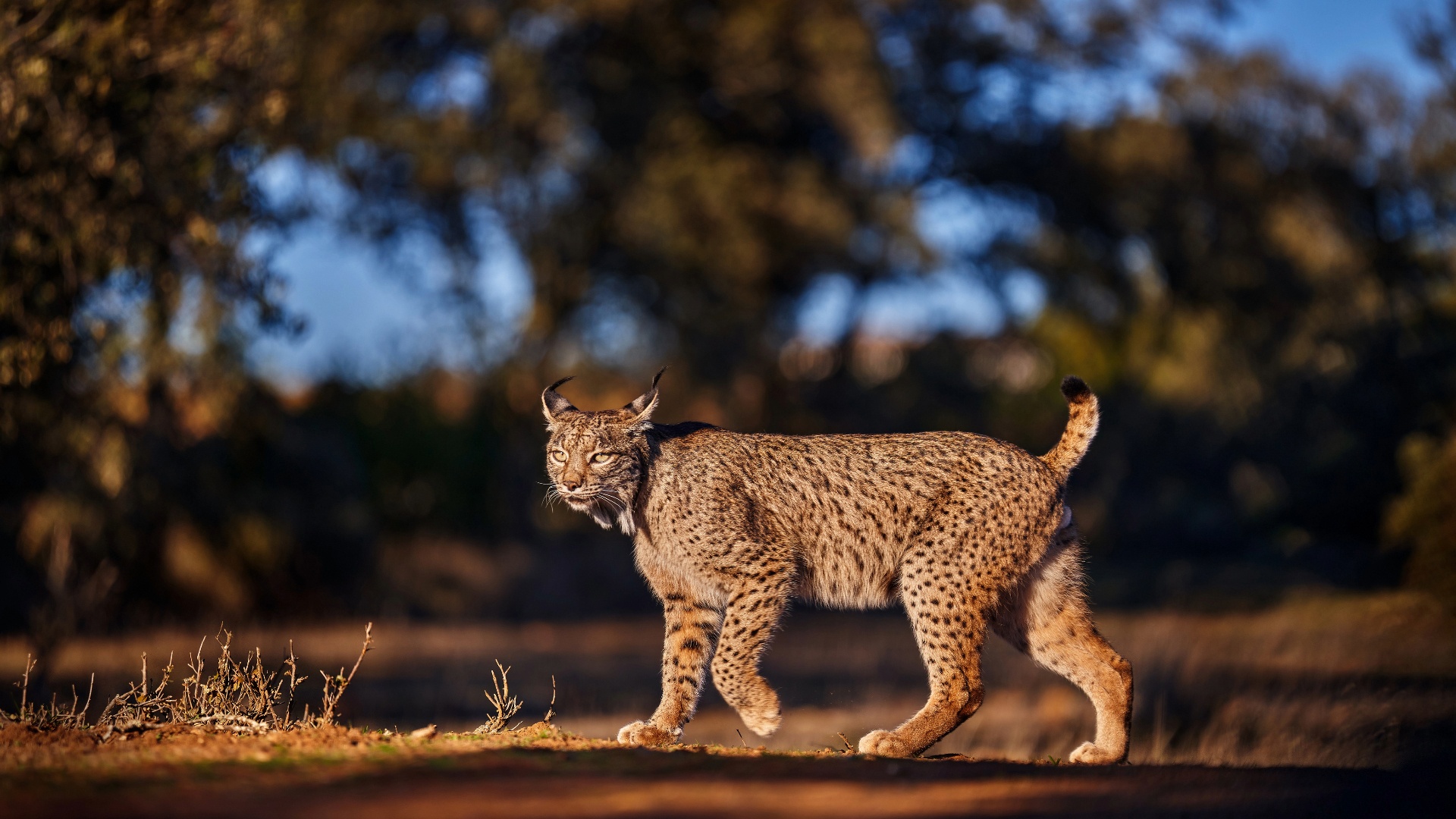
Iberian lynx
The number of Iberian lynxes declined steadily during the 20th century, and at the beginning of the 2000s, only two isolated breeding populations remained, both located in southern Spain. These populations totaled about 100 adult animals, with only 25 breeding females.
This dramatic decrease was primarily due to habitat destruction, reduction in prey (particularly the European rabbit), and human-induced threats such as poaching, road accidents, and habitat fragmentation and alteration.
The Iberian lynx is not very adaptable because it relies on rabbits for 75% of its food intake. European rabbit numbers have suffered repeated population crashes due to myxomatosis and rabbit hemorrhagic disease.

Thanks to reintroduction and captive breeding projects, the Iberian lynx population has significantly increased. Nature-based Solutions (NbS) have been pivotal for the lynx’s recovery. These strategies include the establishment of wildlife corridors and the preservation of the species’ natural habitat, which not only benefit the lynx but also support other species and enhance local ecosystems.
One of the cornerstones of this success has been the active restoration of Mediterranean scrub and forest habitats. The European rabbit has also received full protection, which is crucial for the survival of the Iberian lynx.
To further bolster Iberian lynx resilience against threats like disease and poaching, conservationists implemented translocations and an ex-situ breeding program to enhance genetic diversity. This comprehensive approach has made the Iberian lynx more robust and better able to withstand environmental pressures.
These successes were achieved through the dedicated collaboration of government bodies, scientific institutions, NGOs, private companies and local communities. These groups have formed a multifaceted conservation strategy supported by the European Union LIFE project. WWF has played a pivotal role in various initiatives, demonstrating the power of collective effort.

Key conservation actions have included:
This expansion was achieved through significant reforestation efforts, land management and the creation of wildlife corridors. According to WWF, these restored habitats have not only supported the lynx but also benefited other species like the imperial eagle and various amphibians.
WWF has been heavily involved in habitat protection, prey management and public awareness campaigns. WWF-Spain has secured custody agreements with 18 estates covering more than 62,000 acres, to protect lynx habitats and boost rabbit populations. Additionally, WWF’s captive breeding program has released 45 lynxes into their natural habitats by mid-2015, significantly aiding the species’ recovery.

WWF’s commitment to the Iberian lynx has spanned several decades, focusing on critical conservation areas:

By 2022, the population of mature individuals had risen to 648, with the total population (including young lynx) exceeding 2,000. IUCN Director General Dr. Grethel Aguilar noted, “The improvement in the Red List status of the Iberian lynx shows that successful conservation works for wildlife and communities alike.”
Despite the remarkable recovery, the Iberian lynx still faces several challenges:
Juan Carlos del Olmo, CEO of WWF-Spain, emphasized the need for continued efforts: “To ensure a viable and safe population, we must increase today’s wild Lynx population by threefold by 2040. This requires addressing threats such as accidental killings and legally prosecuting deaths caused by shooting, snares or traps.”

Looking ahead, conservationists have ambitious plans to ensure the long-term survival of the Iberian lynx.
These include:
Francisco Javier Salcedo Ortiz, Coordinator of the LIFE Lynx-Connect project, stated, “There is still a lot of work to do to ensure that Iberian lynx populations survive and the species recovers throughout its indigenous range.”
Dr. Barney Long, from Re: Wild and Co-Chair of the IUCN Green Status Working Group, added, “The significant recovery of the Iberian lynx demonstrates that even the most threatened species can be brought back from the brink of extinction through committed, science-based conservation action.”

Nat Hab hosts a European adventure kayaking Portugal’s Upper Duoro River Valley. On the August through October itinerary, guests paddle through the Douro International Natural Park, with Portugal on one bank and Spain on the other.
The 335 square mile protected area was created in May 1998 to protect the inspiring scenery and wildlife, including eagles, red kites, griffon vultures, herons, wild boar and one of the last packs of wolves in the Tras-os-Montes region, which lives a few miles inland from the river. Natural vegetation covers the banks along this stretch of the river, with woodlands of juniper and cork oak beyond.
There are no established Iberian lynx populations in the Douro Valley—yet. Recent conservation efforts have focused on expanding the lynx’s range across the Iberian Peninsula and maintaining plentiful prey populations in the Duoro Valley.
These efforts have led to sightings and the establishment of lynx populations in other parts of Portugal, particularly in the Guadiana Valley. Thanks to targeted reintroduction programs, in the Guadiana Valley, there were 53 breeding females, 100 kits and a total of 291 specimens in 2023.
The Douro International Natural Park’s conservation activities, such as habitat restoration and biodiversity protection, contribute indirectly to the overall health of ecosystems that support numerous species, including the Iberian lynx. The park’s efforts in maintaining healthy habitats and promoting sustainable land use practices are crucial for the broader conservation initiatives that benefit the lynx population in Portugal.
Conservationists hope that lynx could expand into more suitable habitats within Portugal, including areas like the Upper Douro Valley.

Once teetering on the brink of extinction, the Iberian lynx has made an astonishing comeback, demonstrating the power of dedicated conservation efforts. The story of the Iberian lynx is far from over. According to WWF estimates, Iberian lynx numbers would need to reach 3,000-3,500 individuals, including around 750 reproductive females, to be eligible to be considered as being in a ‘favorable State of Conservation’ according to European regulations.
Continued conservation efforts that address threats to lynx, support the recovery of decimated rabbit populations, help create new lynx populations, and connect existing ones are critical to reaching such a goal by 2040. The Iberian lynx’s remarkable rebound is a powerful testament to the effectiveness of dedicated conservation efforts. From a population of just 62 mature individuals in 2001 to over 2,000 in 2024, the lynx’s recovery is one of the greatest recoveries of a cat species ever achieved through conservation. It underscores the importance of collaborative, science-based conservation actions.

The post Iberian Lynx make a Remarkable Recovery in Portugal first appeared on Good Nature Travel Blog.